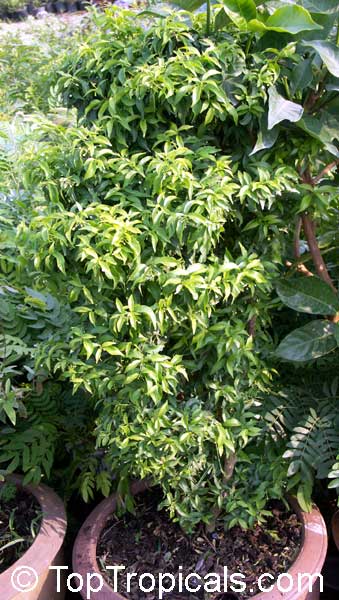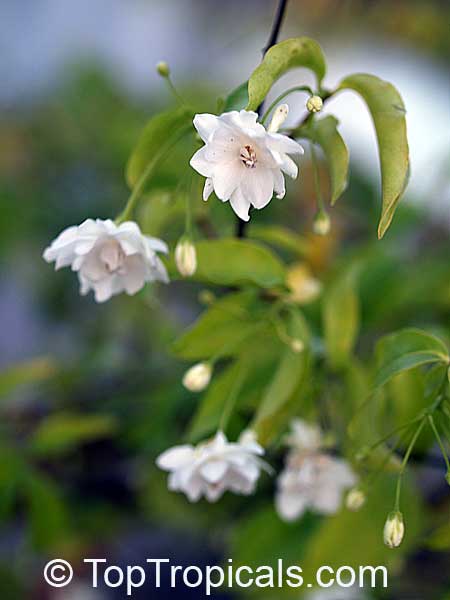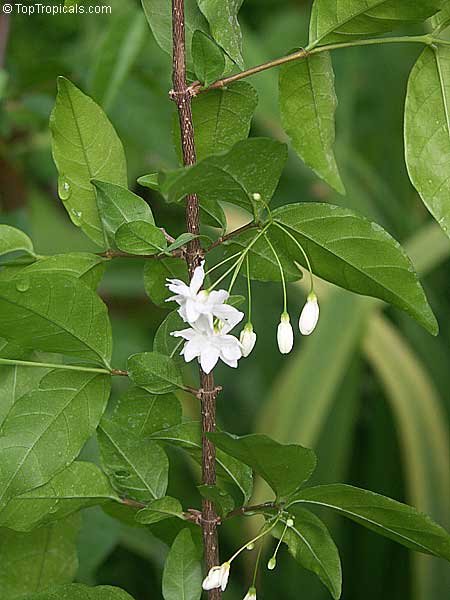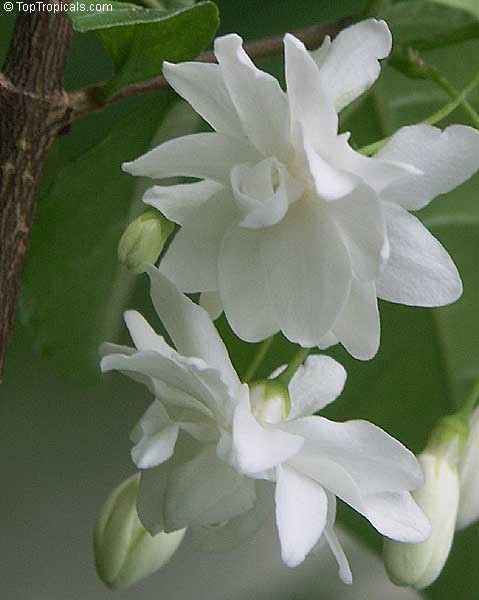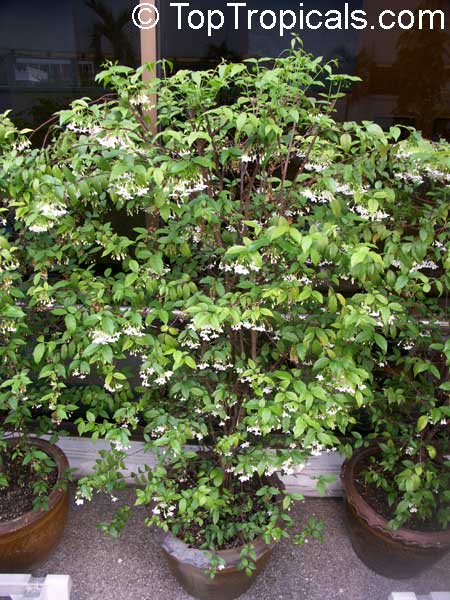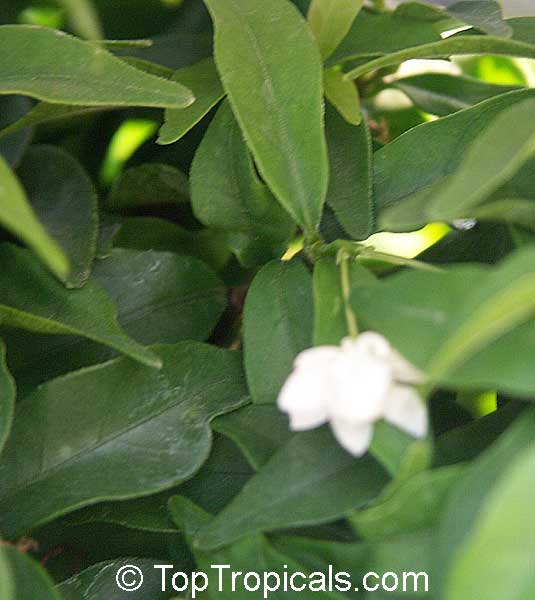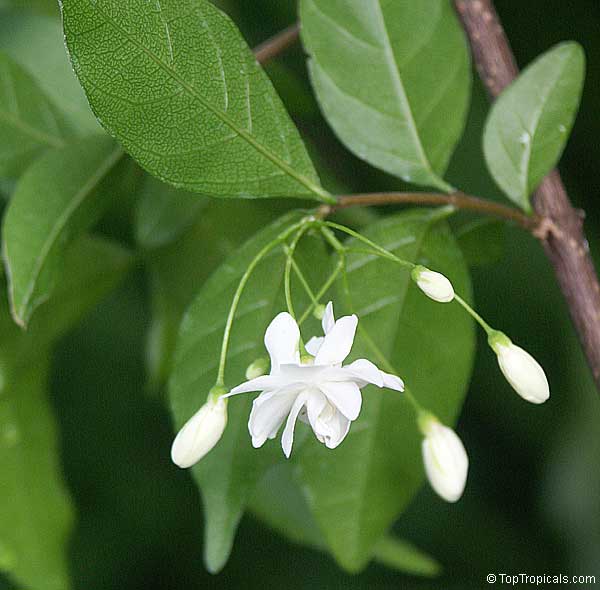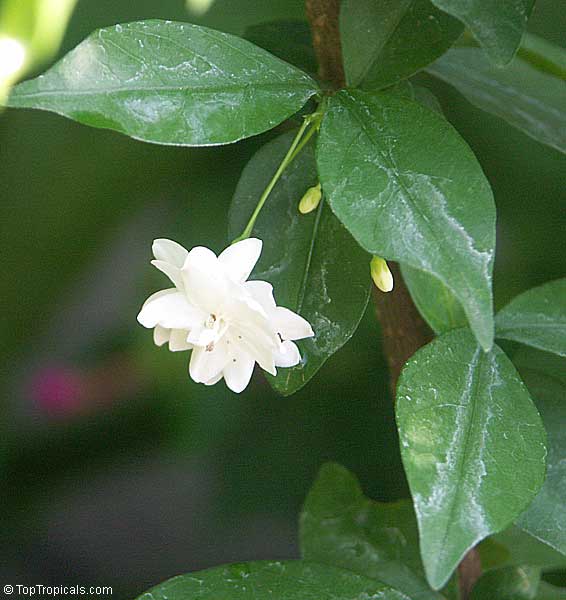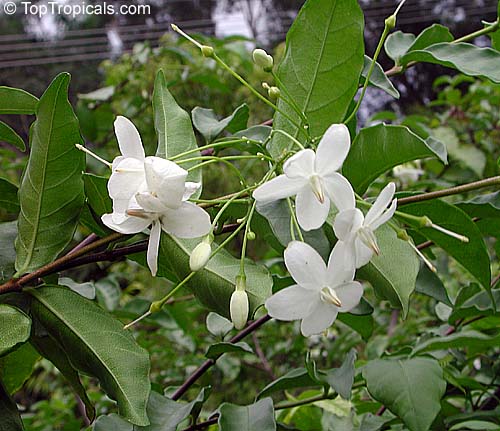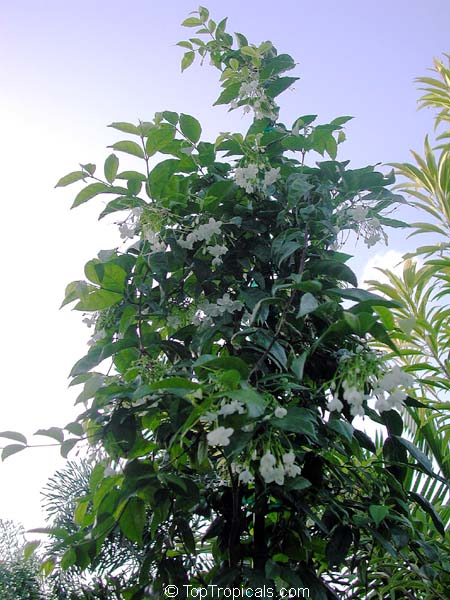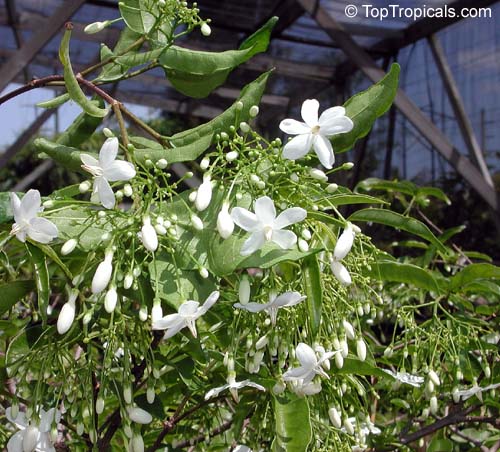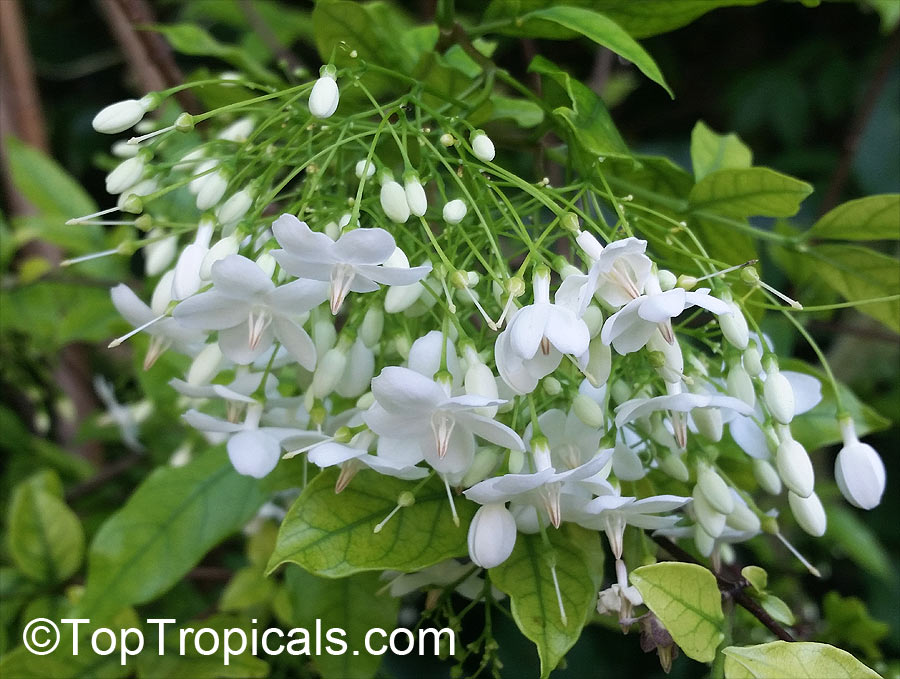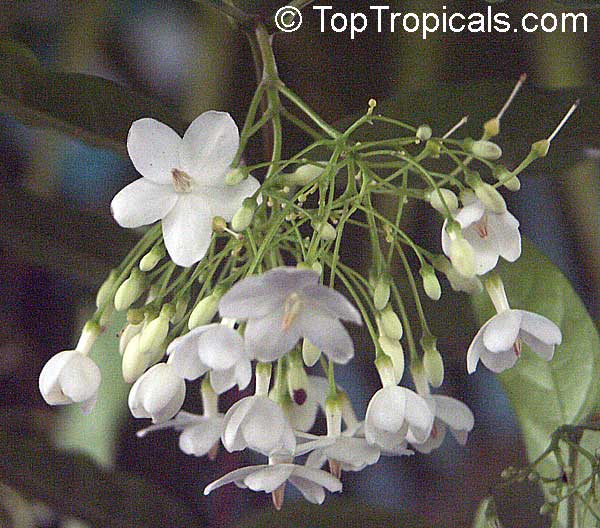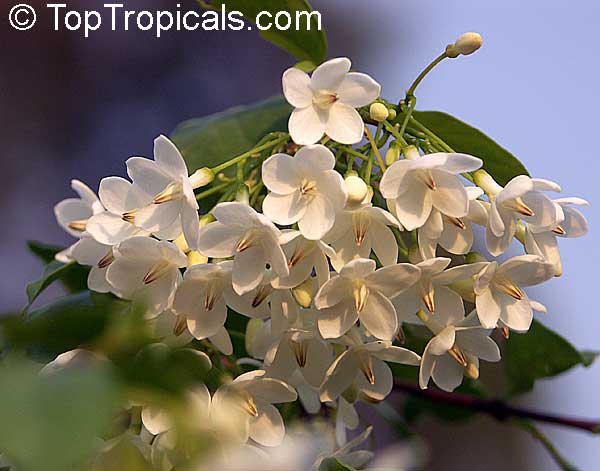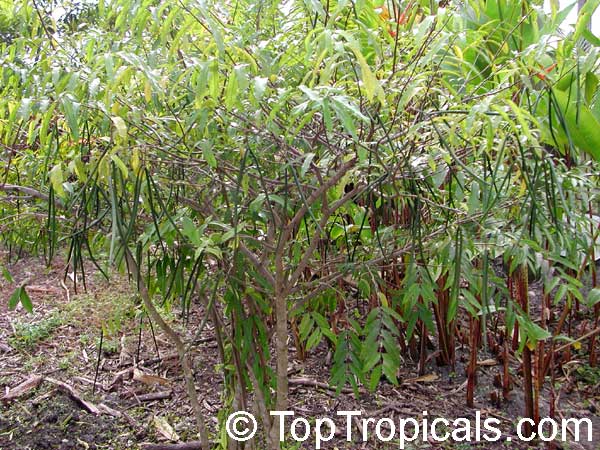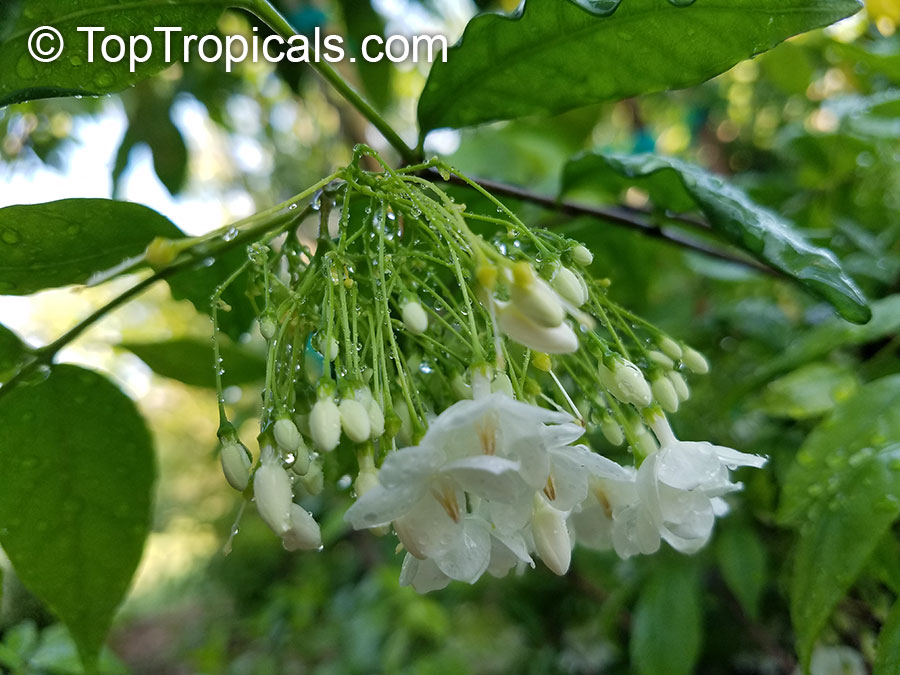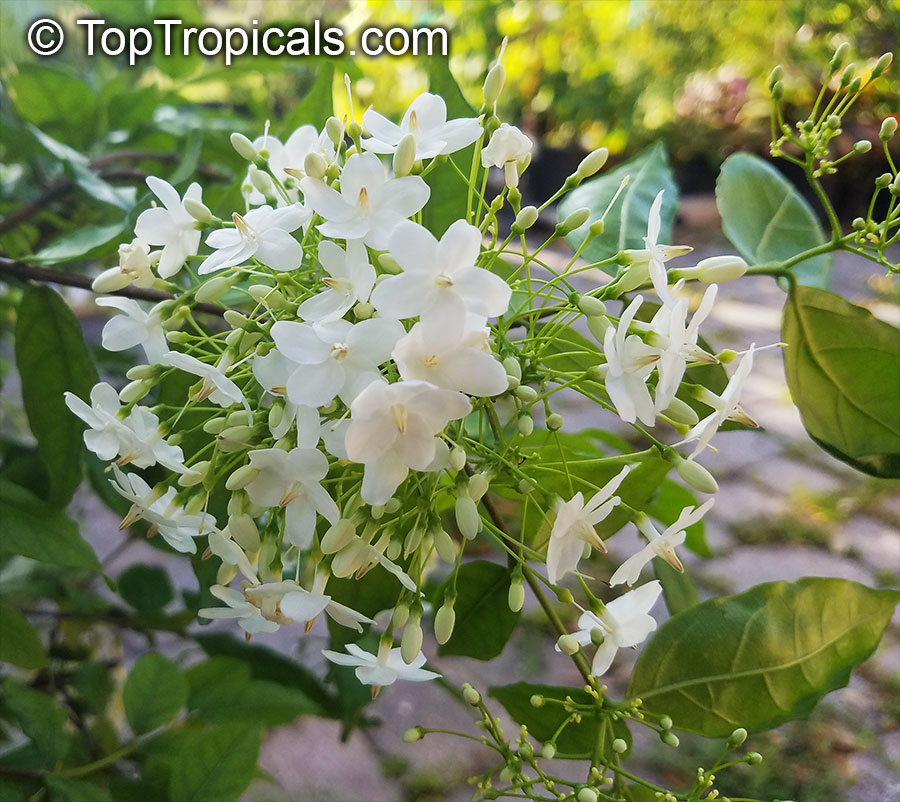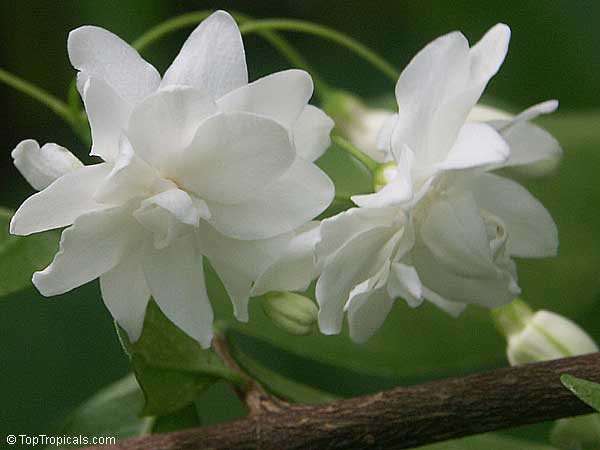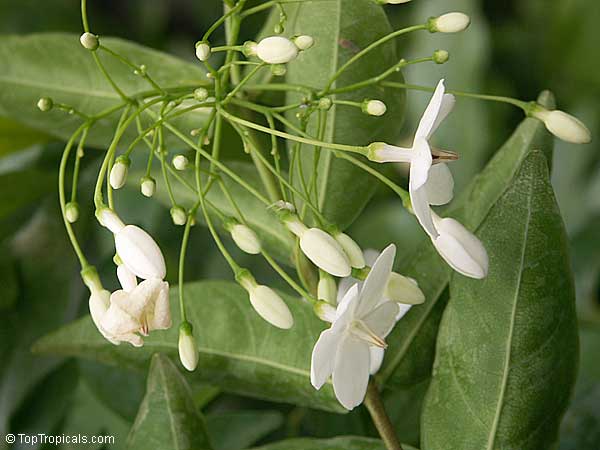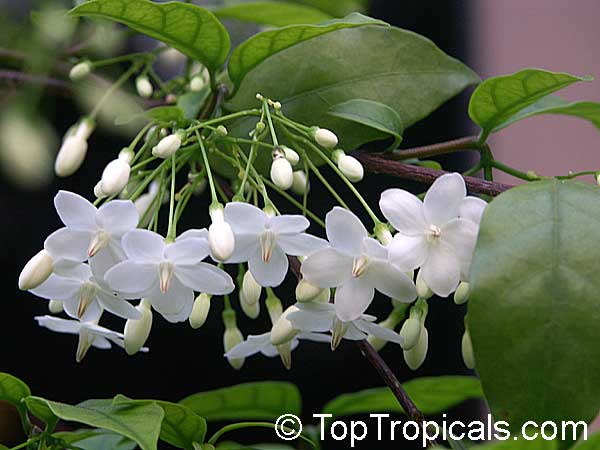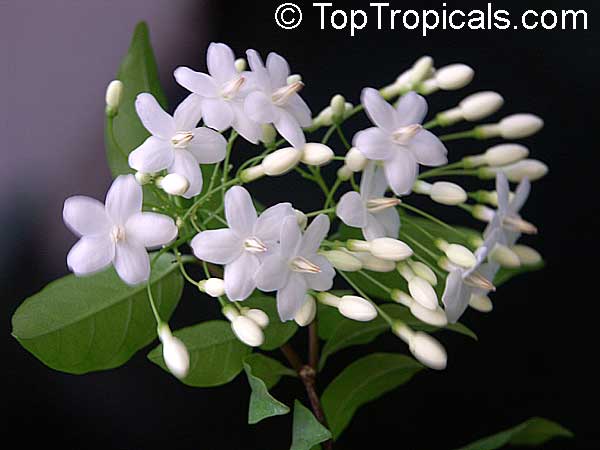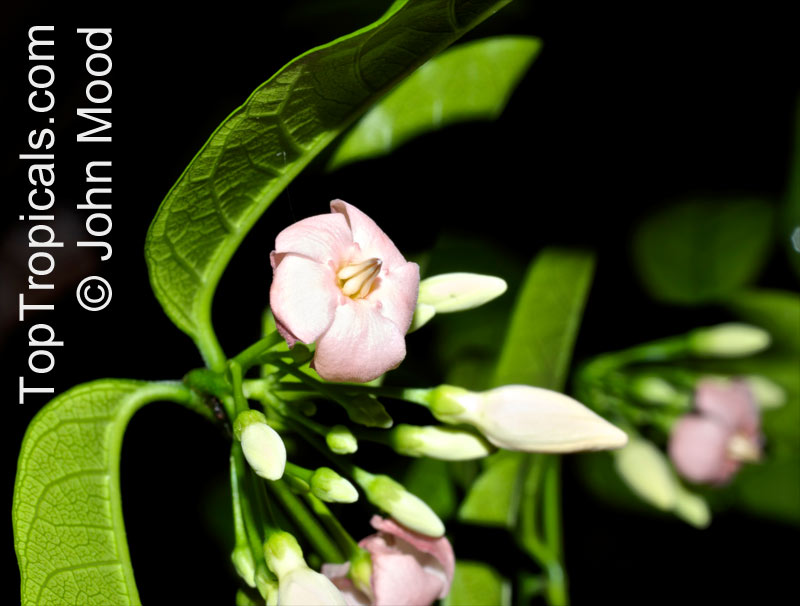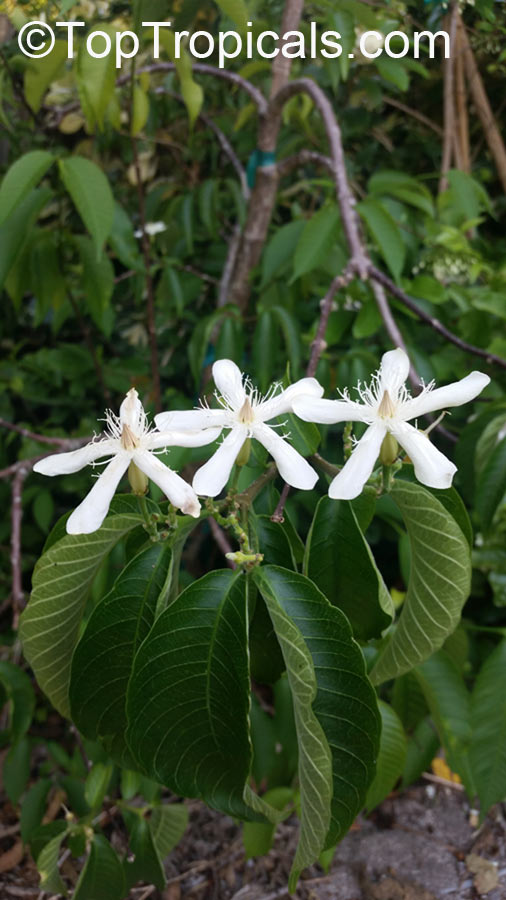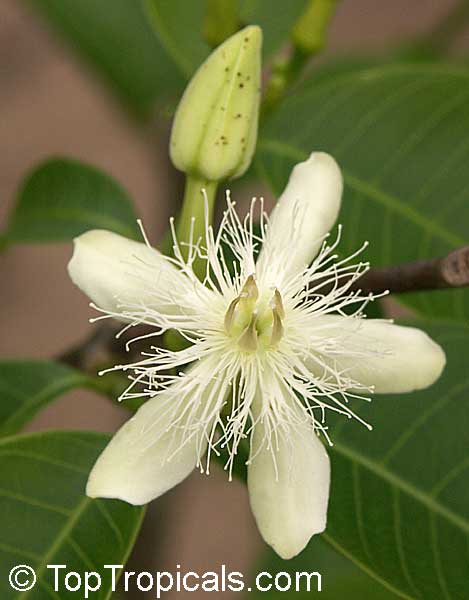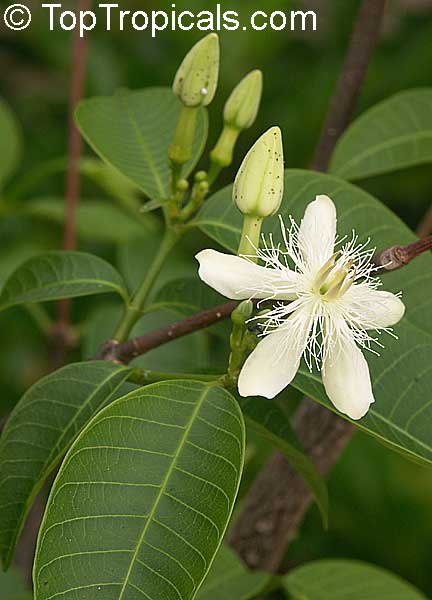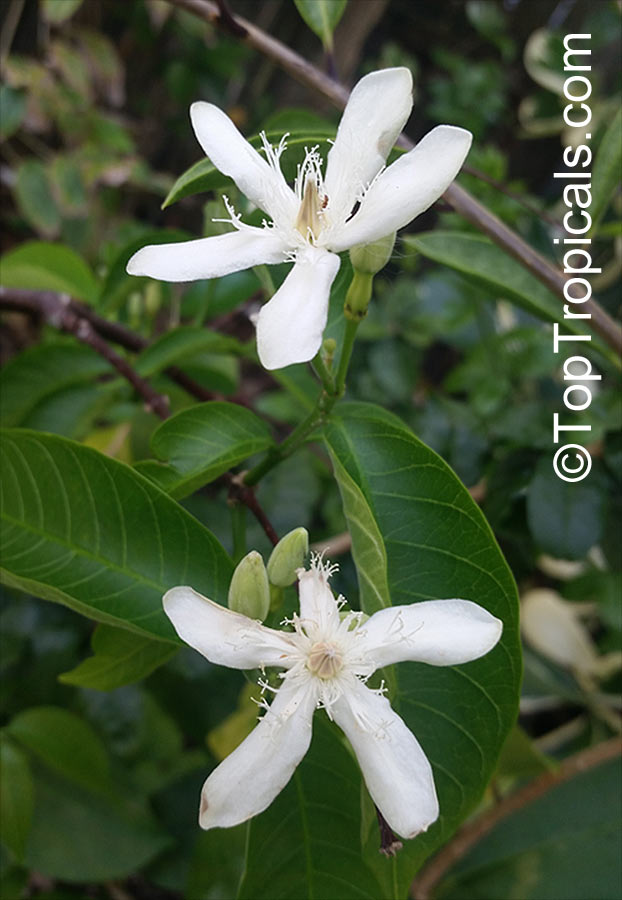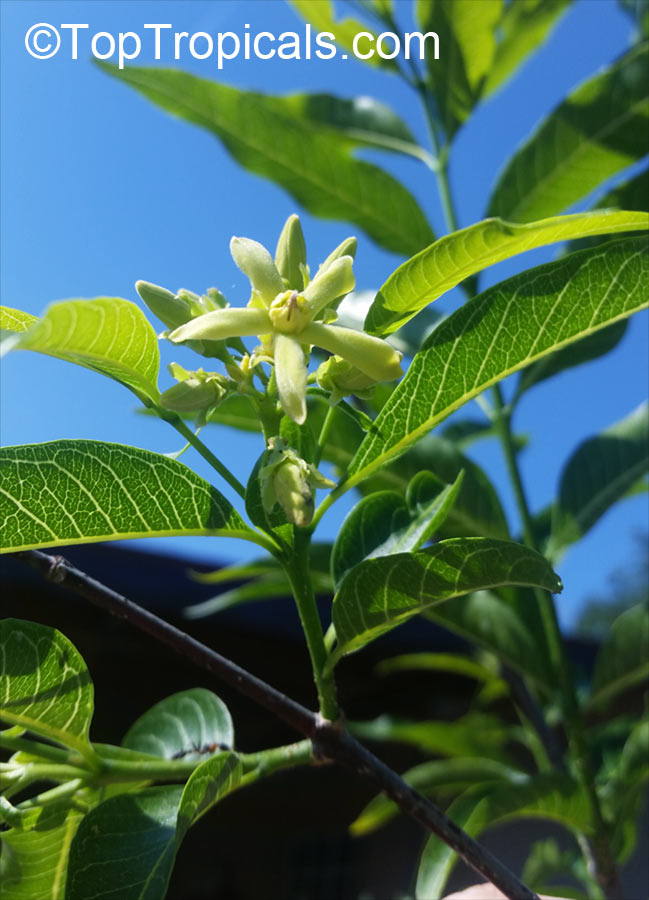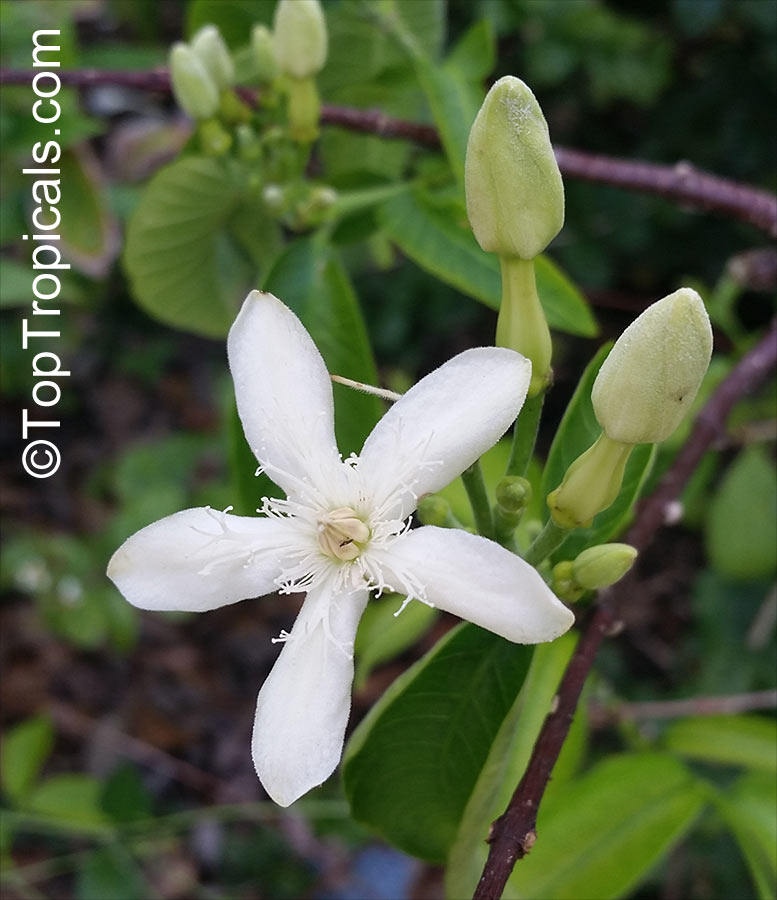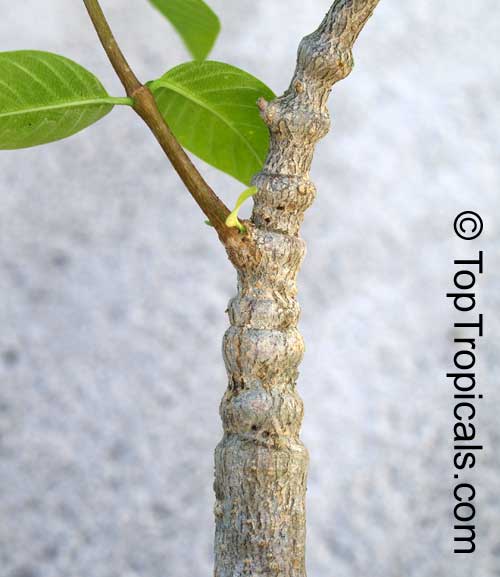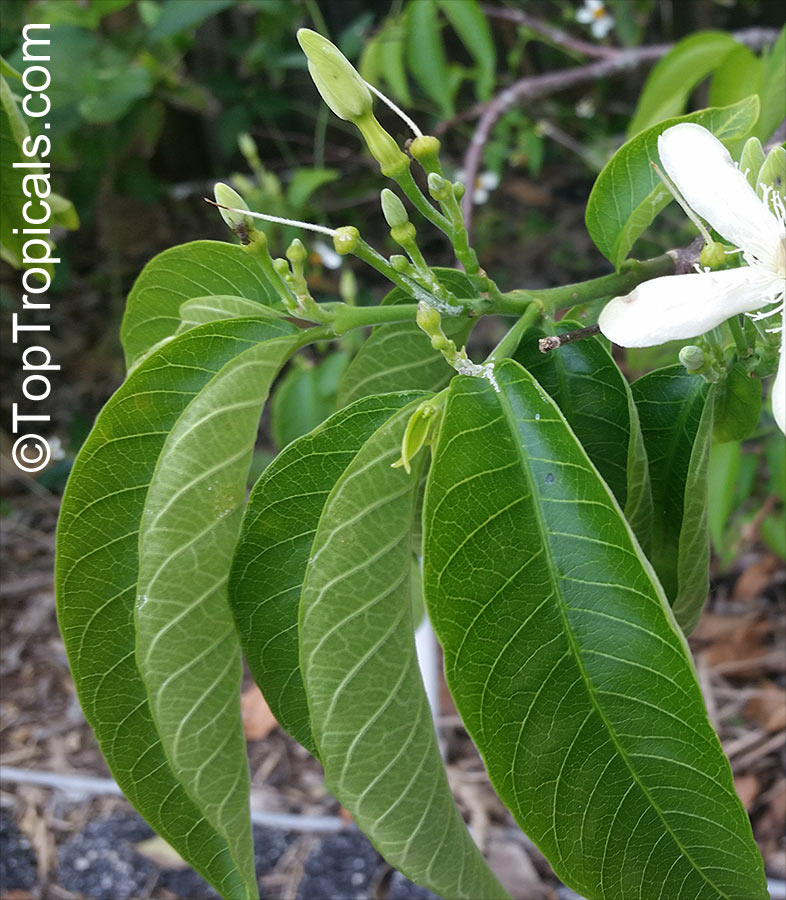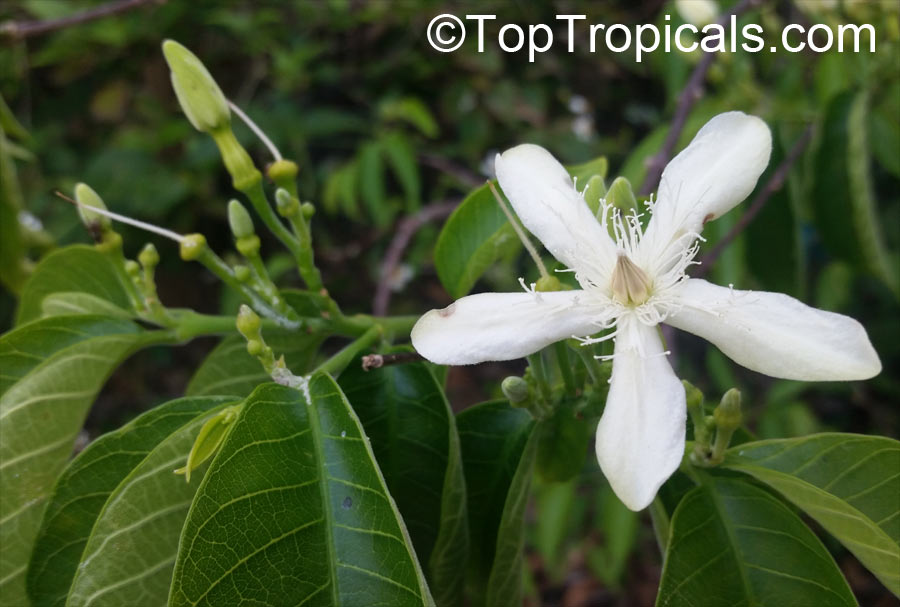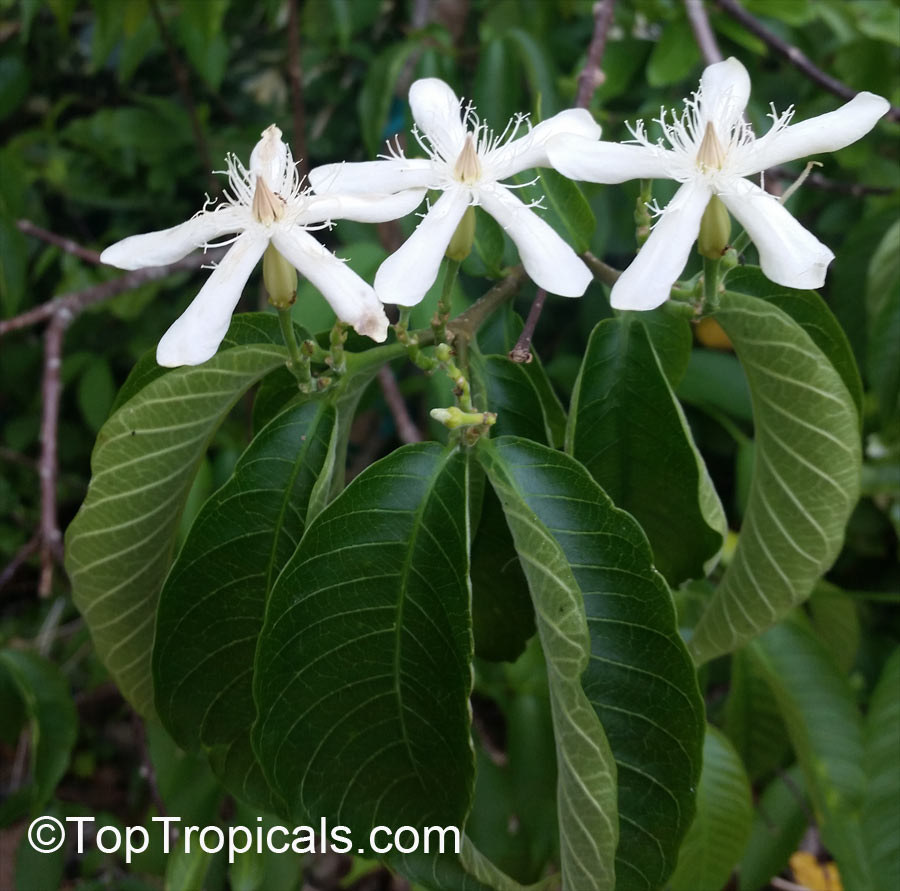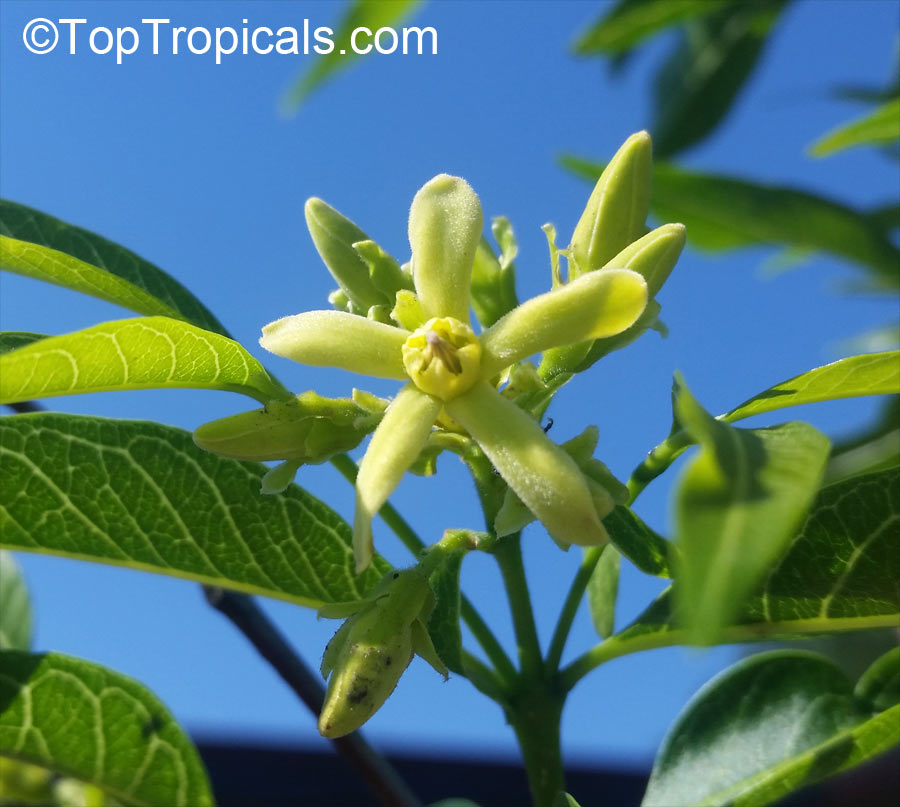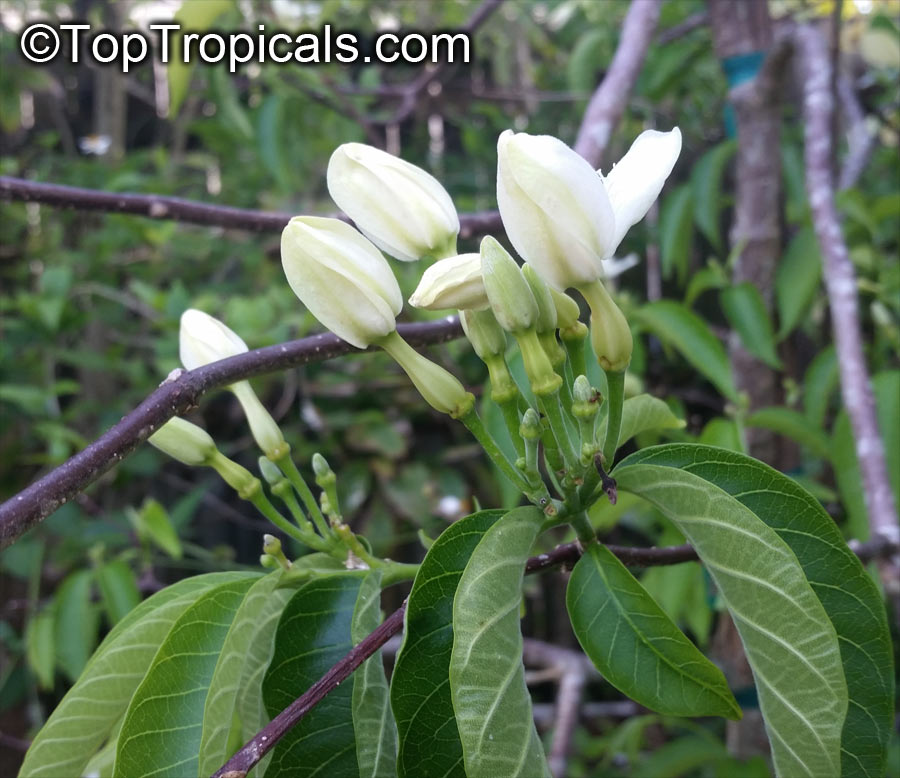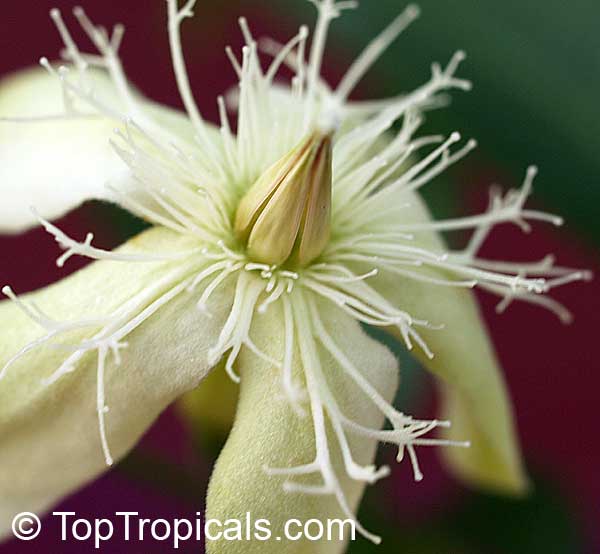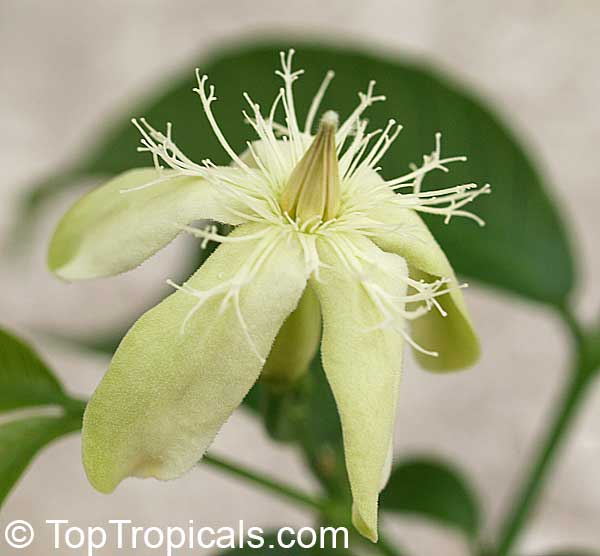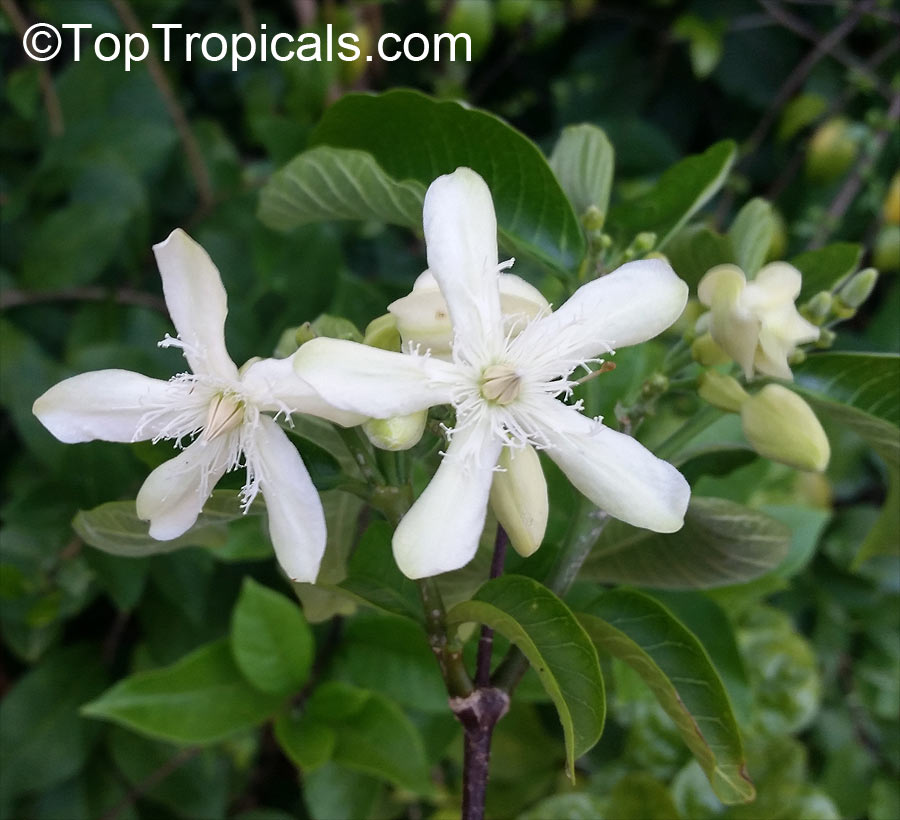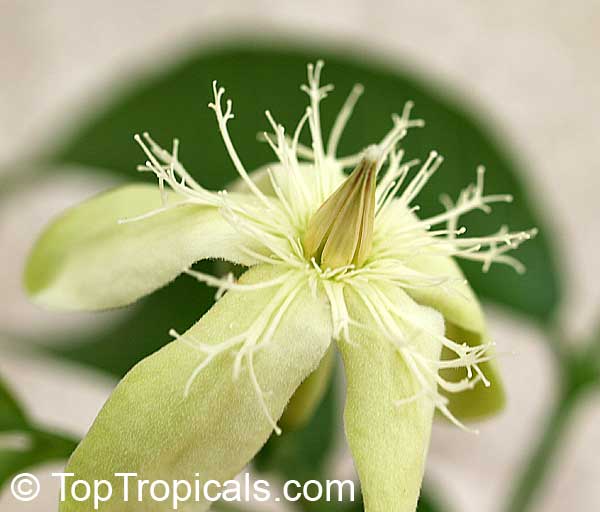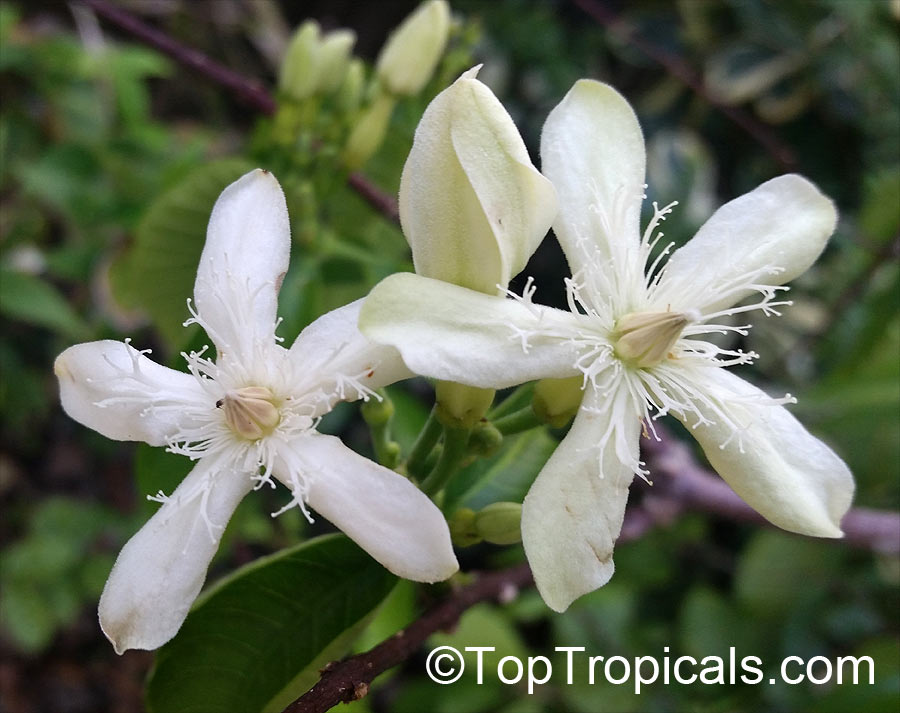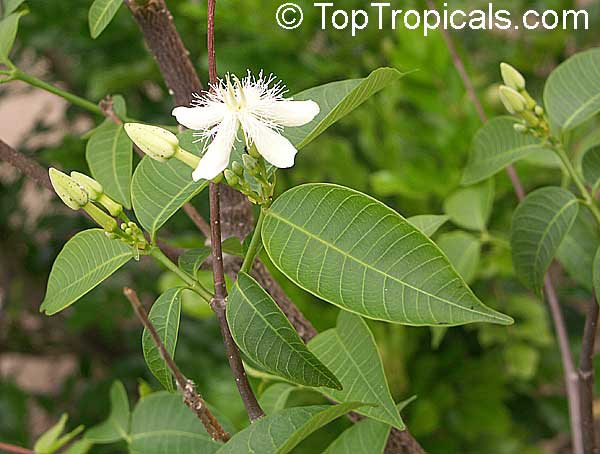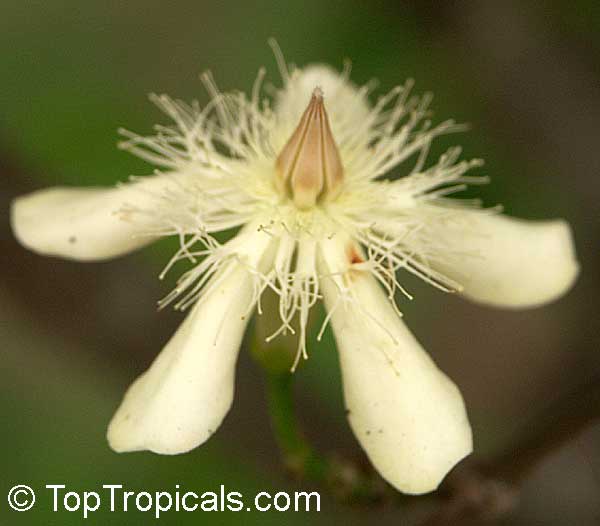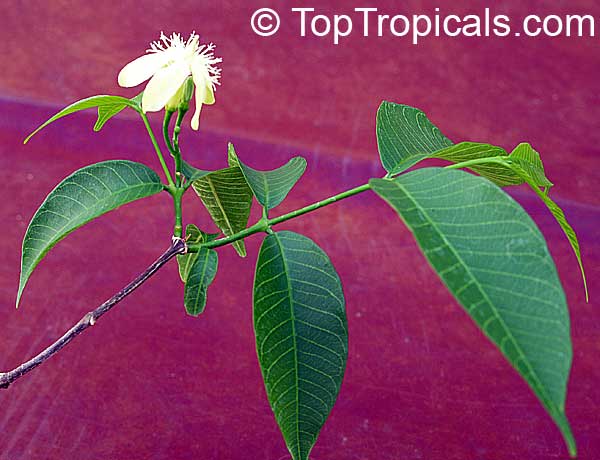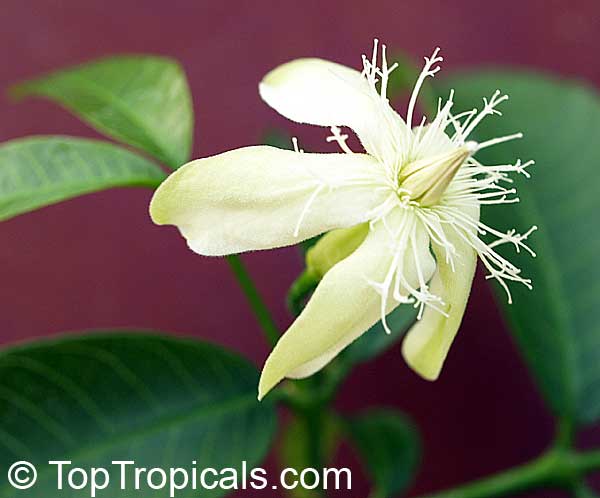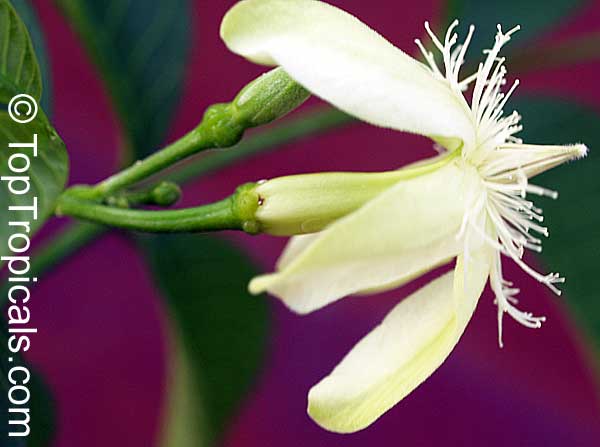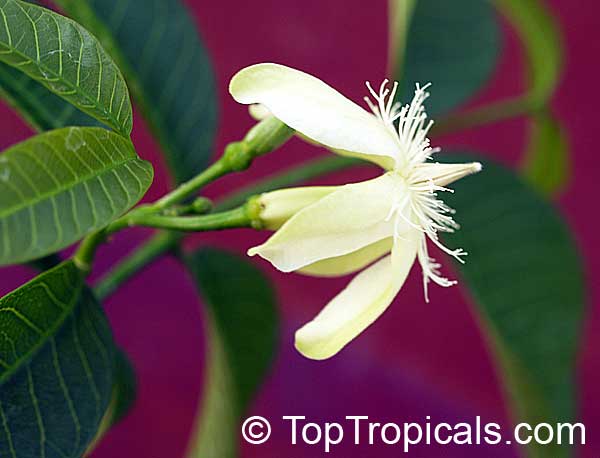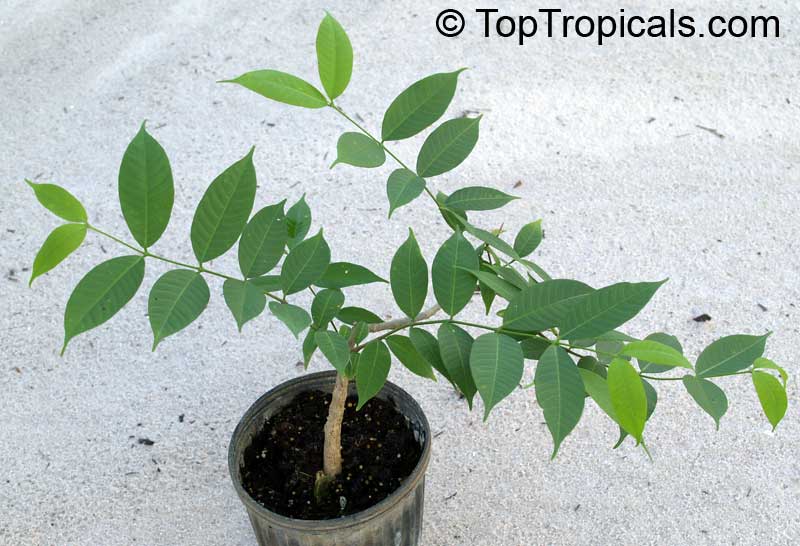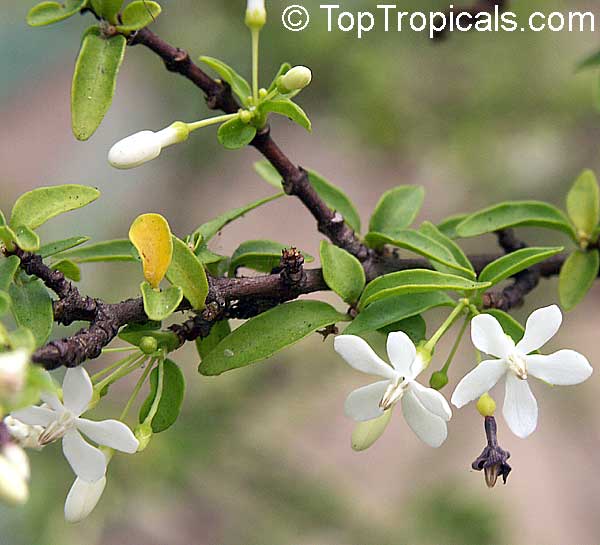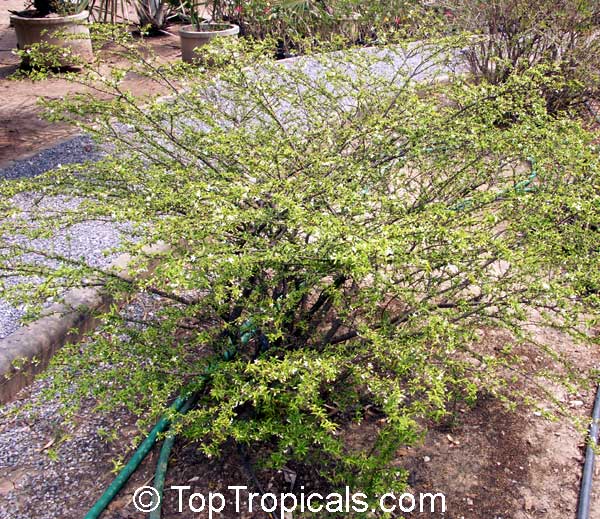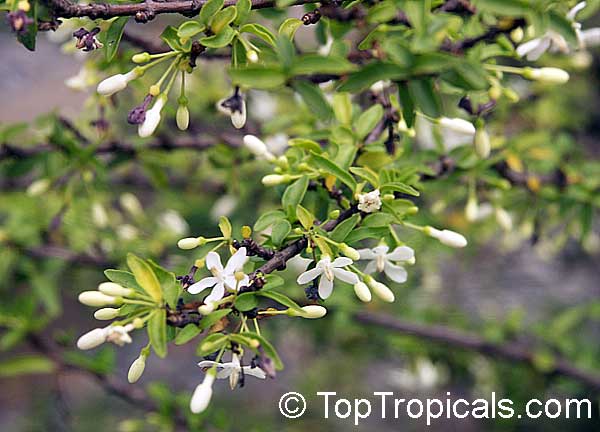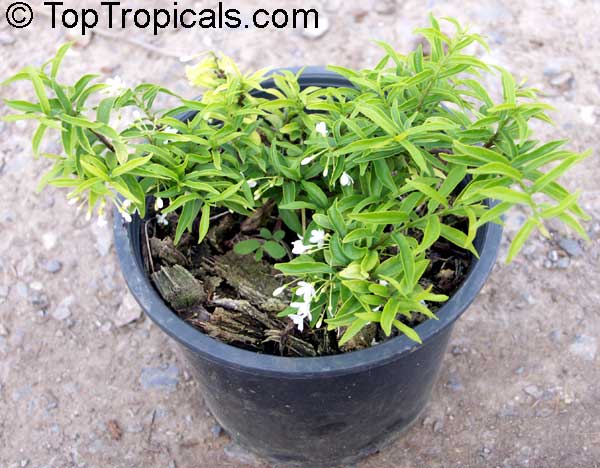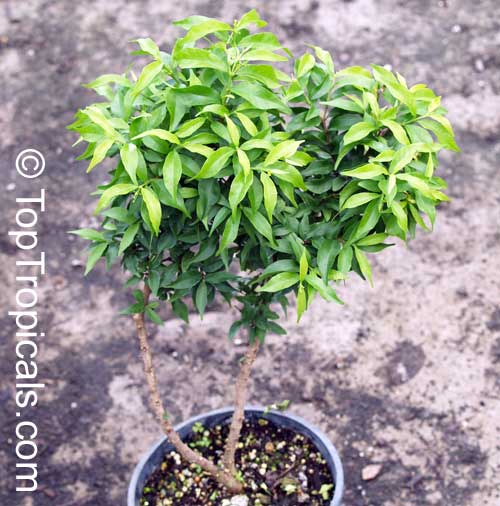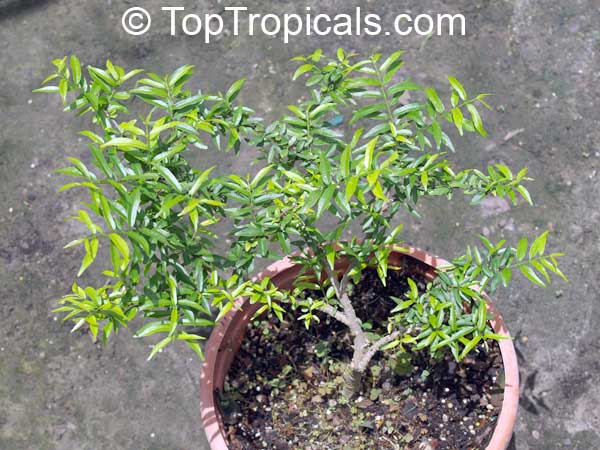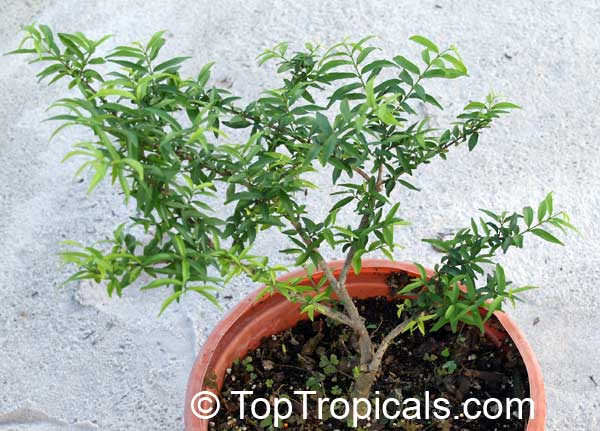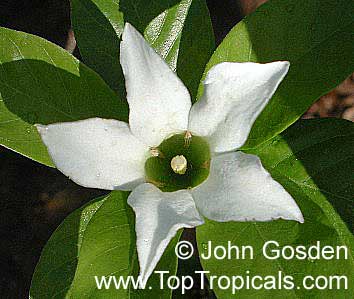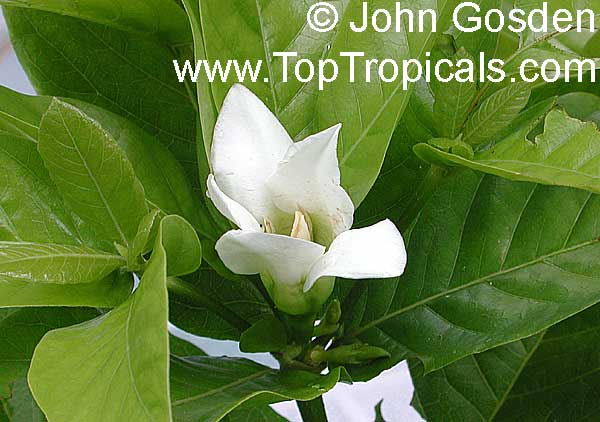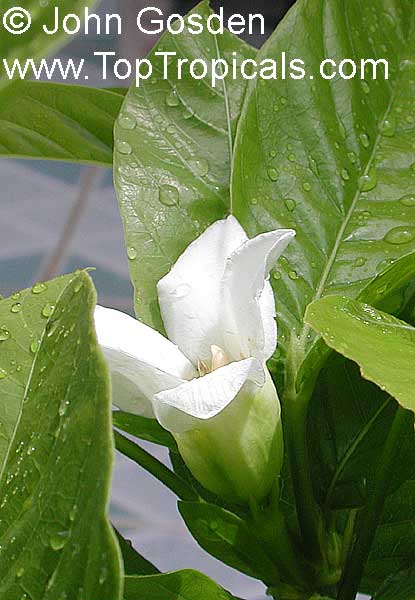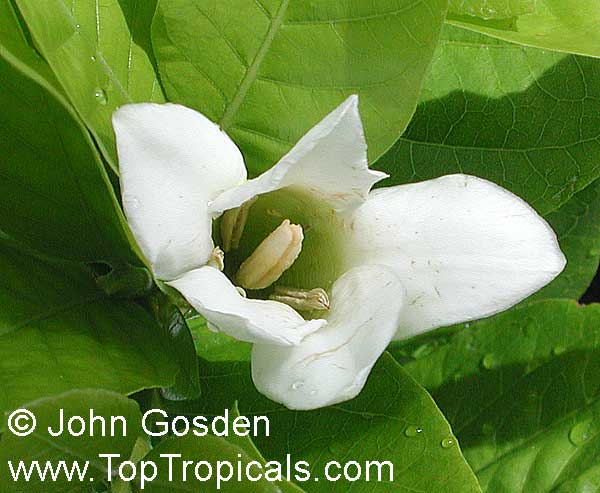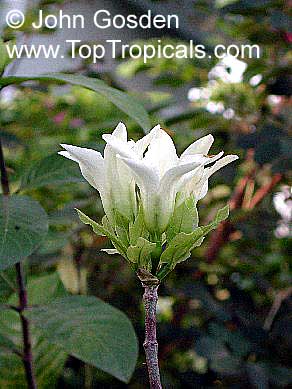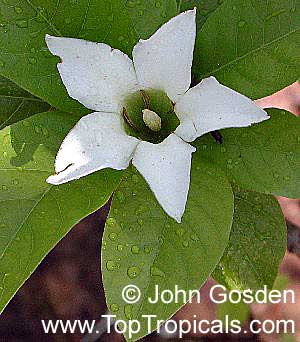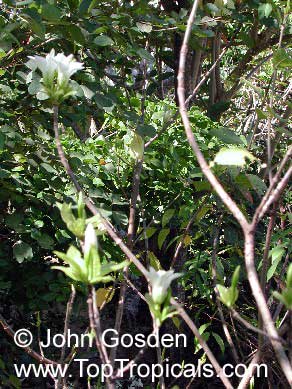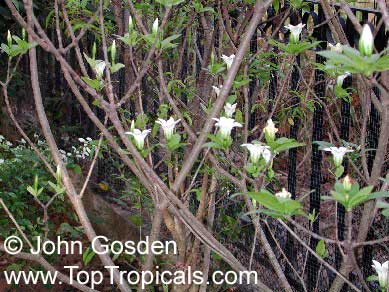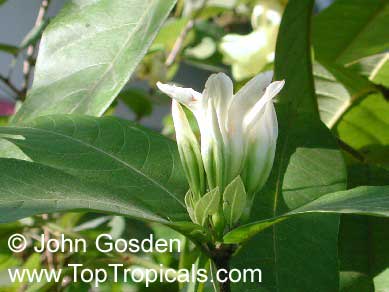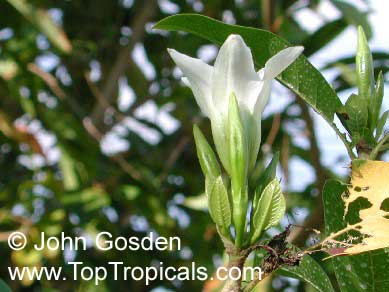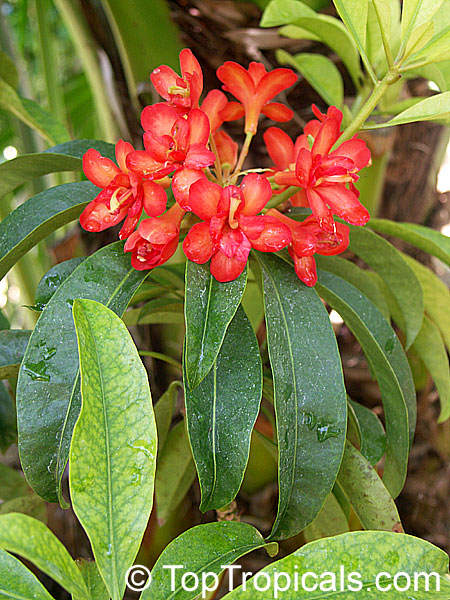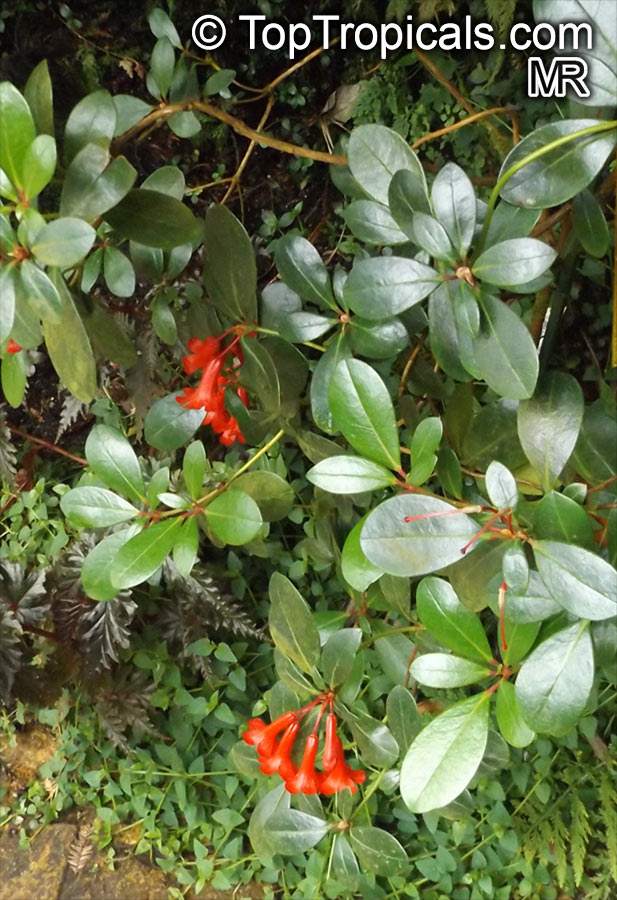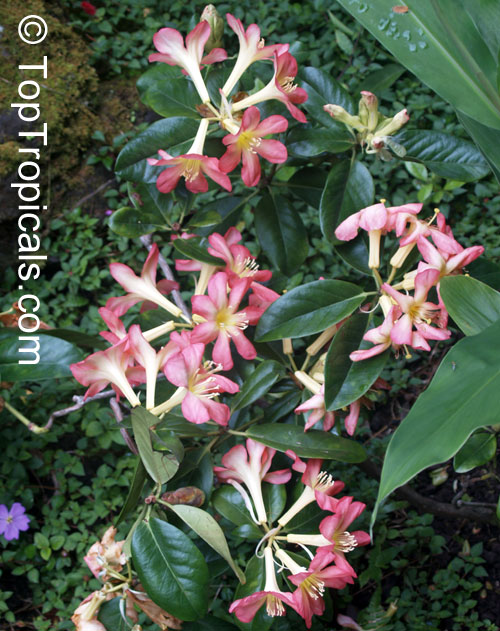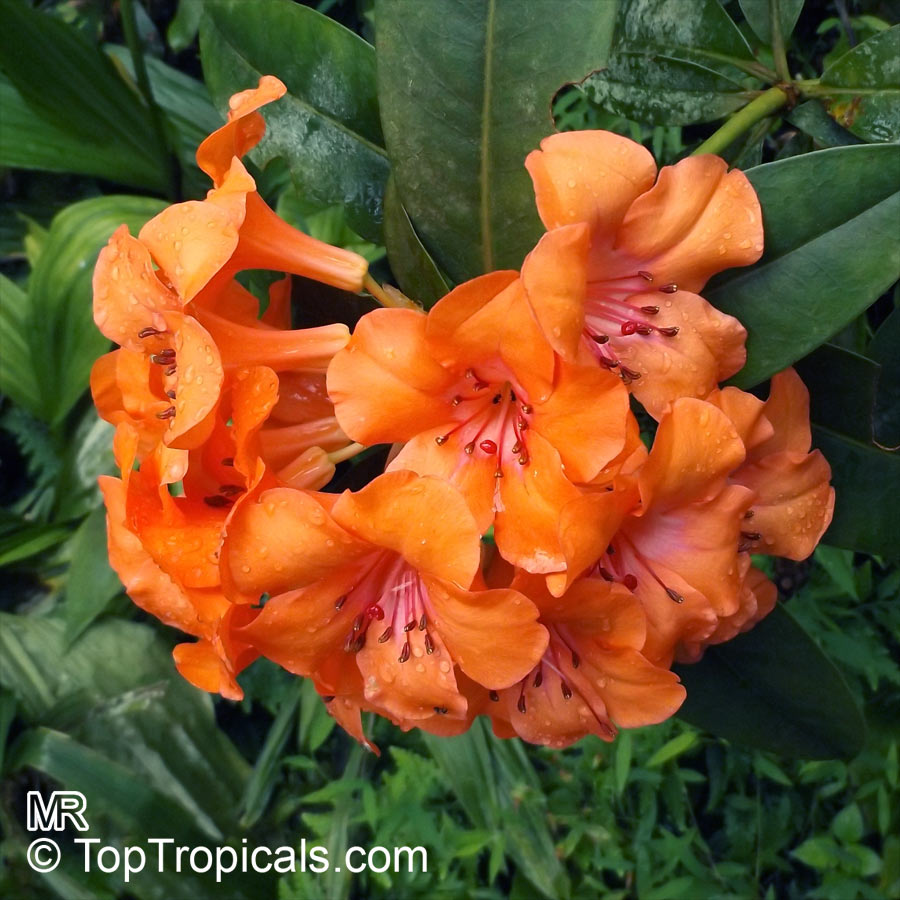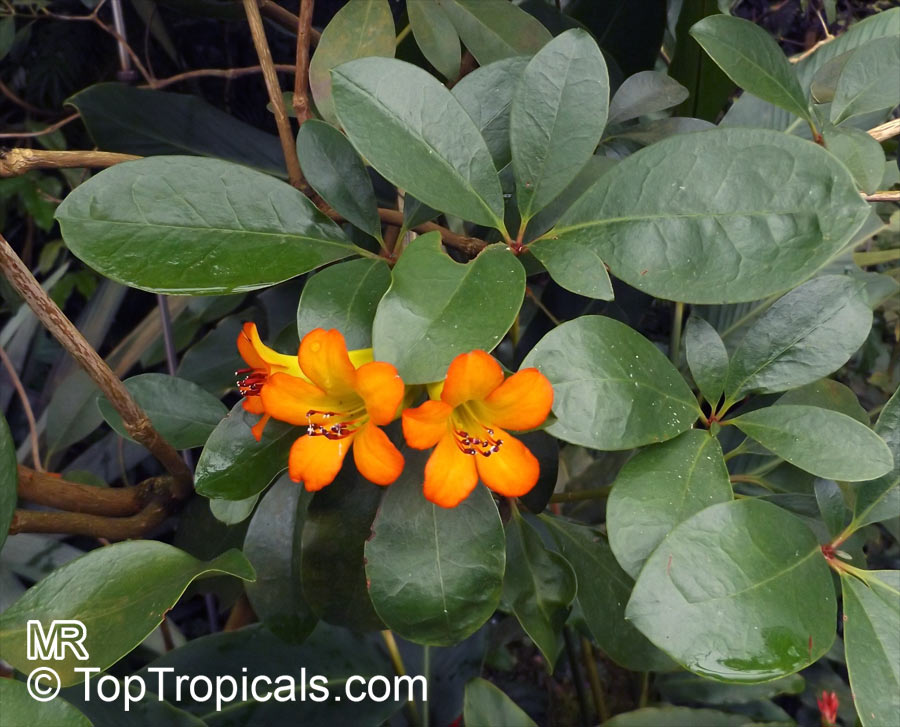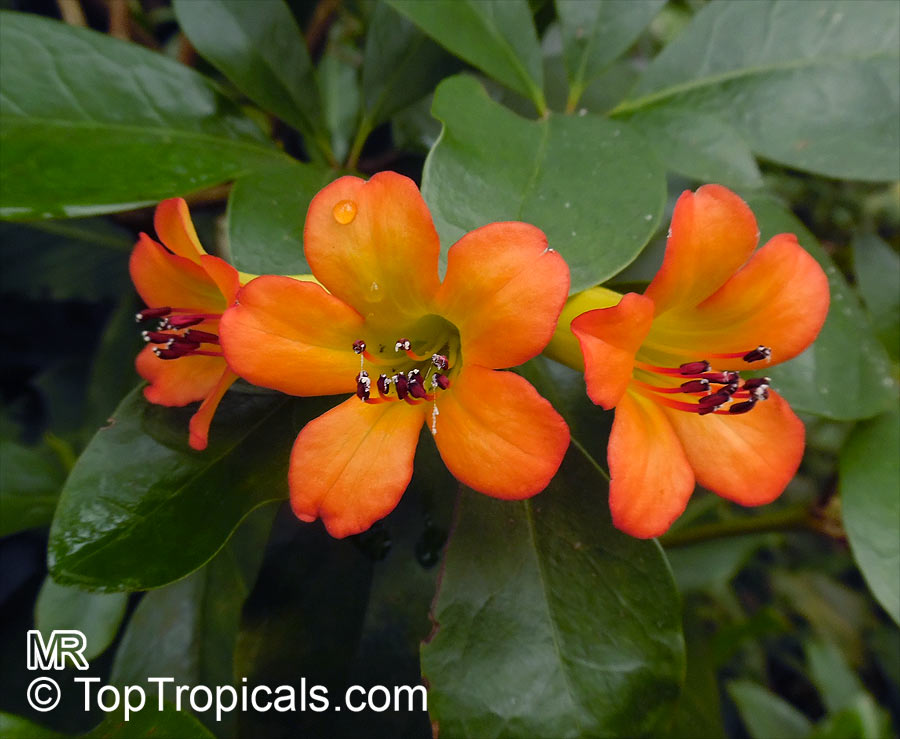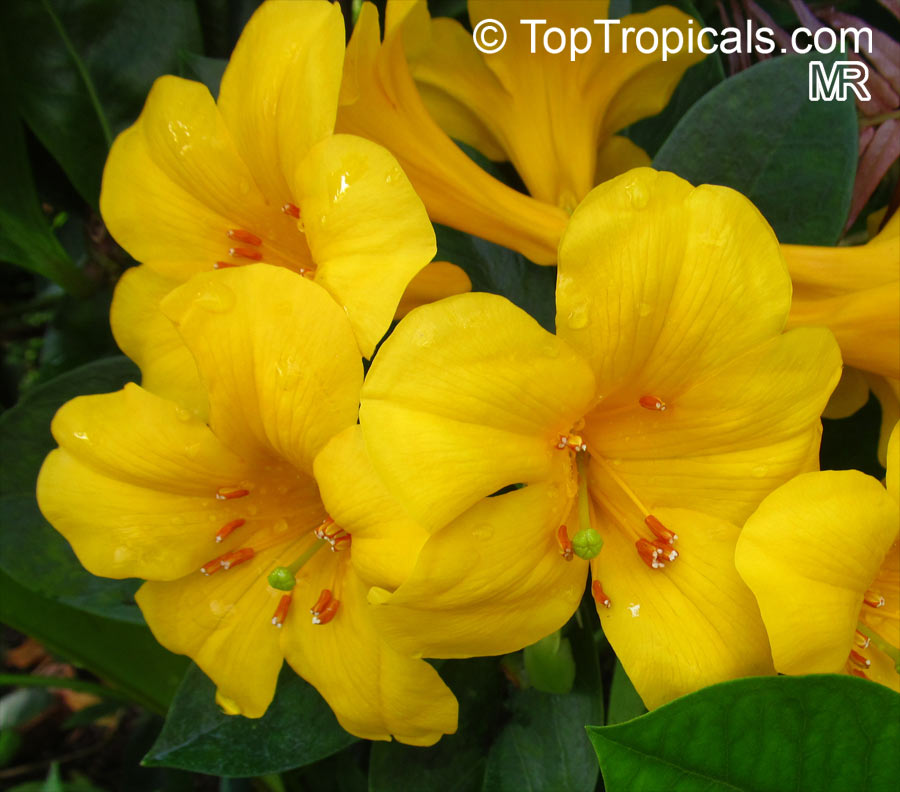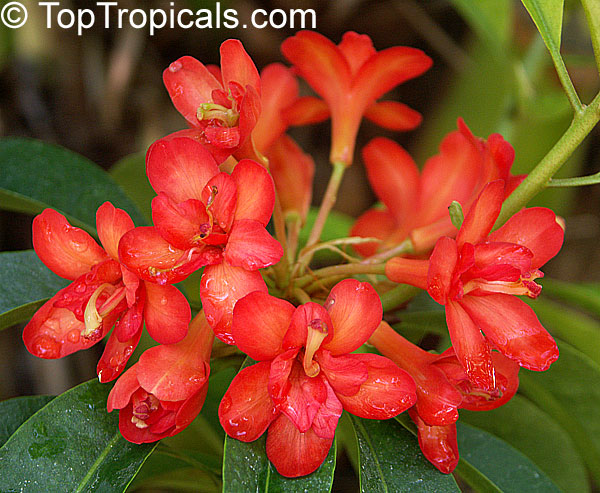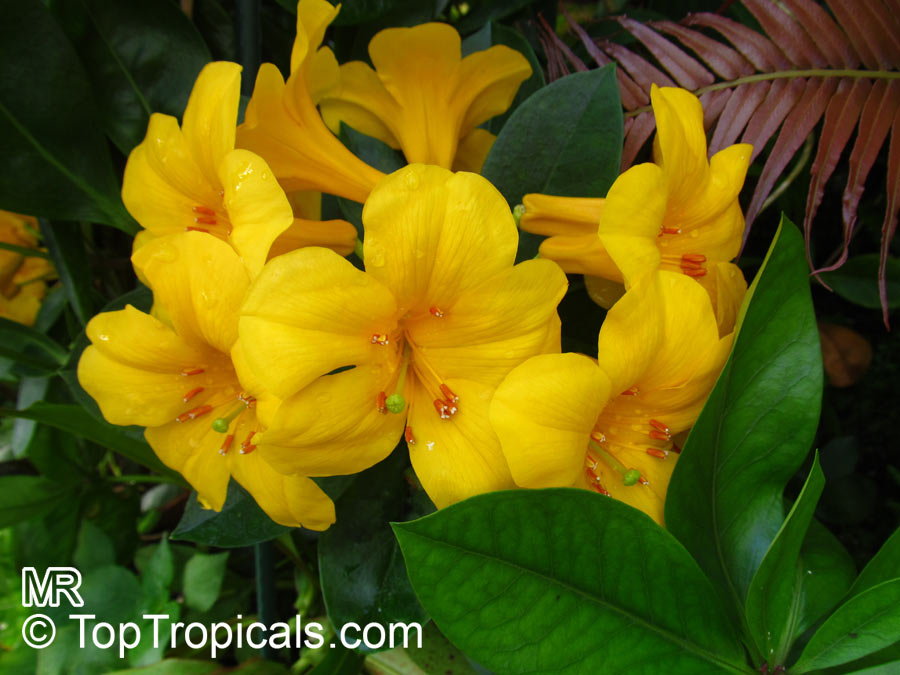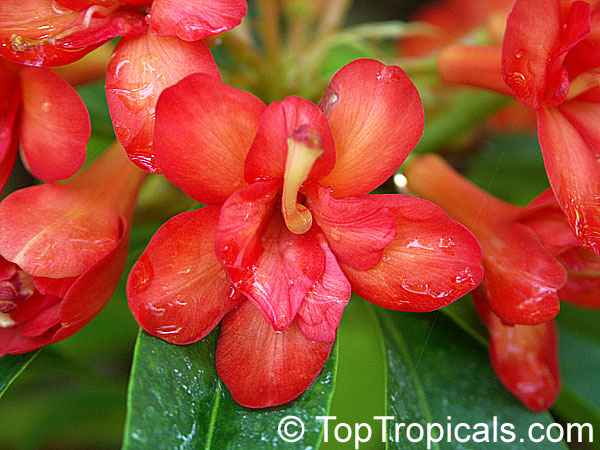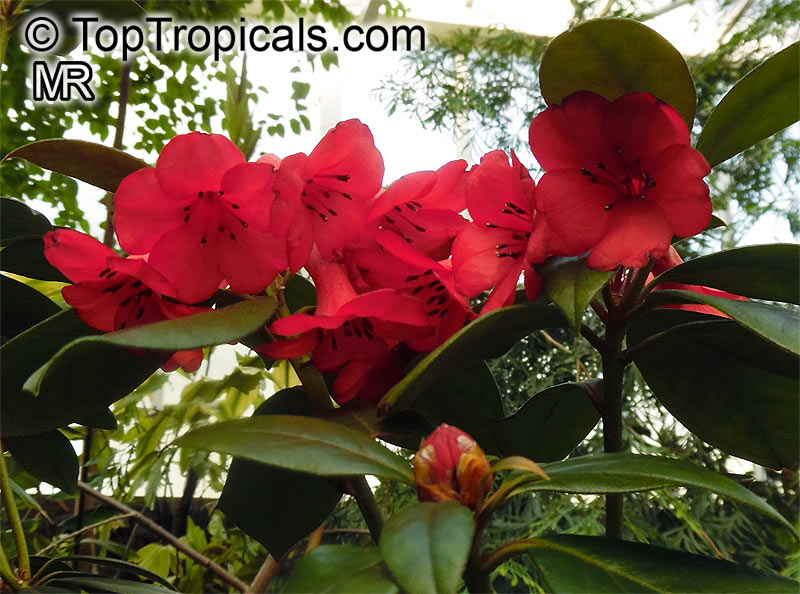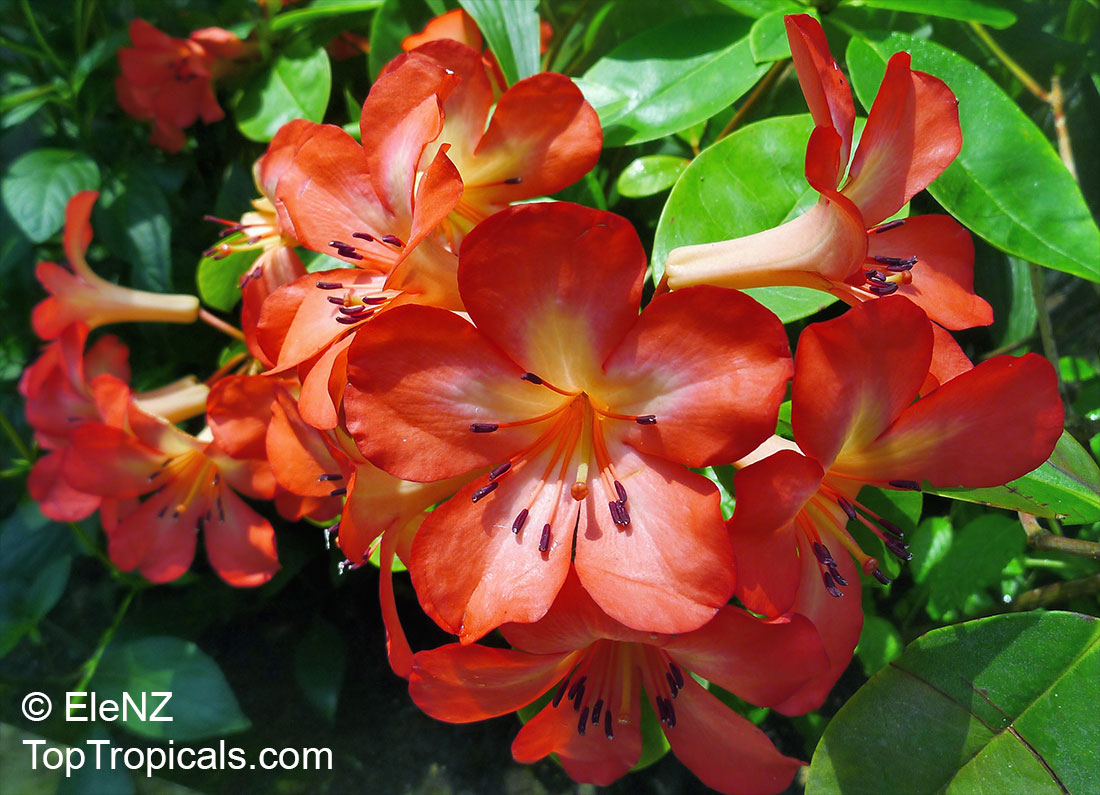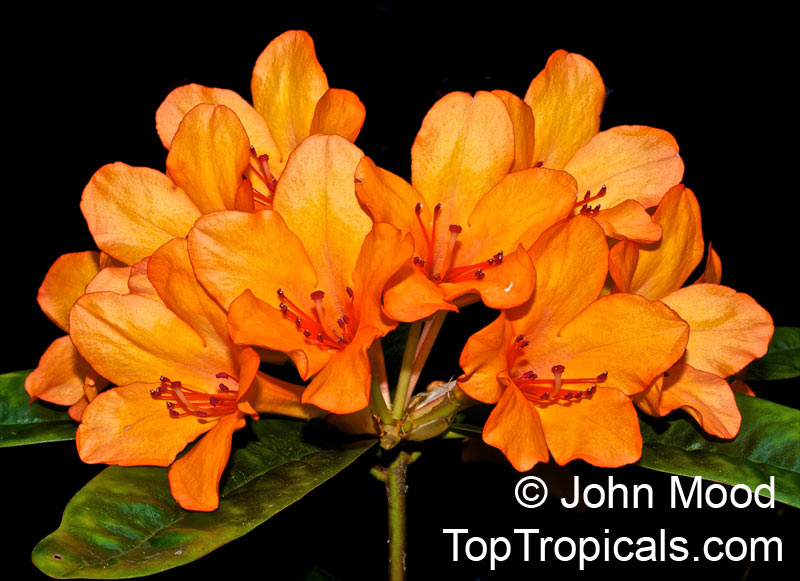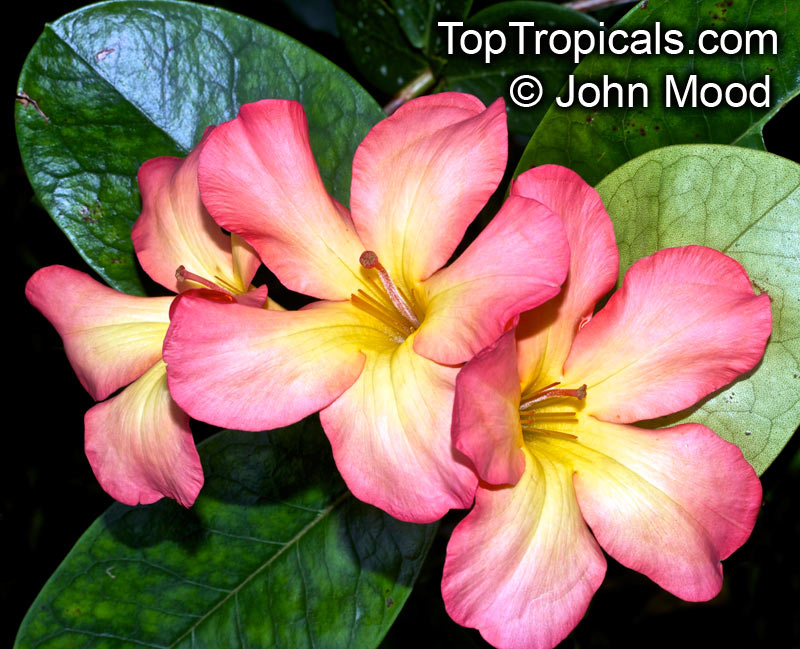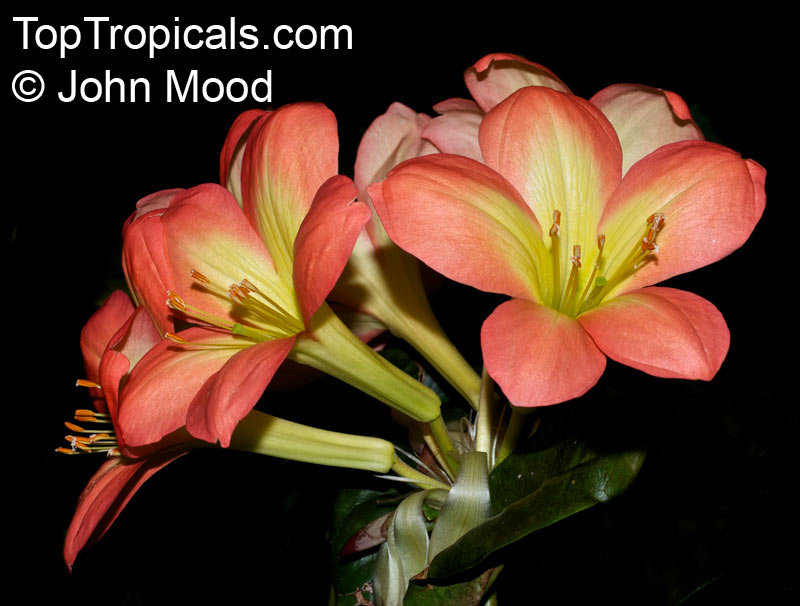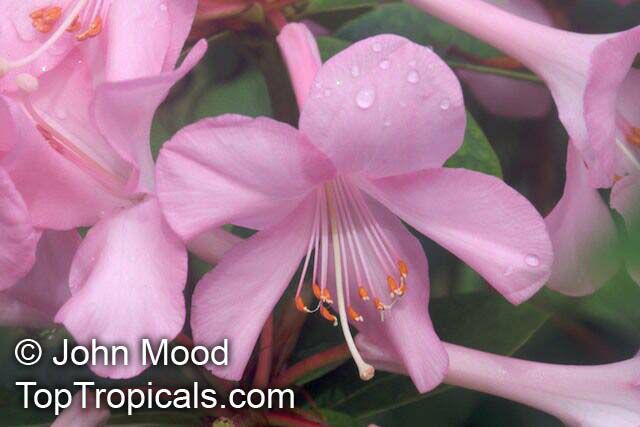Wrightia - Plant Encyclopedia Results
Top Tropicals Plant Encyclopedia
| Number of plants found: 8 |
Botanical name: Wrightia antidysenterica
Common names: Snowflake, Milky way, Winter Cherry Tree, Arctic Snow, Pudpitchaya, Sweet Indrajao, Hyamaraca
Family: Apocynaceae
Origin: Sri Lanka









A small compact and bushy shrub that blooms non stop year-round. The plant all covered with 1" white flowers that look like little stars from a distance. It is a perfect specimen for limited space garden or patio. Can be easily grown as a houseplant. Doesn't require additional pruning. It is a medicinal plant in India. The bark possesses anti-microbial and anti-infammatory properties and therefore the juice extracted from it is administered for mouth sores. The leaves are used in treating several skin disorders, psoriasis, nonspecific dermatitis etc. The bark is used as an adulterant for the well known drug, Holarrhena antidysenterica. Related species - Wrightia tinctoria.
Botanical names: Wrightia dubia, Cameraria dubia, Wrightia cambodiensis
Common names: Starfish Flower, Red Wrightia
Family: Apocynaceae
Origin: Thailand






This rare species of Wrightia is not fragrant, but flower is an amazing starfish! Flower is about 2" wide and looks waxy, almost artificial. Wrightia dubia (Starfish Flower) can be found in climates of India, Thailand, and other tropical countries. The plant is a large shrub, growing 5-10 ft tall in its natural habitat, but can reach up to 20 ft in the right conditions. The plant grows best in full sun and prefers regular watering.
The crowning glory of this plant is its flowers that appear in mid-to-late spring. The small white blossoms turn into a vivid display of red, crimson or vinous flowers in summer. The flowers are especially attractive to butterflies and hummingbirds, bringing lots of pollinators to your yard. In short, Wrightia dubia is a showy, low-maintenance flowering shrub worthy of its own place in the garden.
Hardy in USDA Zone 9-11. To grow Wrightia dubia in colder climates, it is best to containerize the plant. The shrub should be placed in a large pot to ensure adequate space for root growth, and the pot should be moved indoors during the winter. Keeping soil moist and slightly humid is key to the success of this plant, as is providing the sunlight it needs. Fertilizing in the spring, summer and autumn is also recommended. With a bit of extra care, your Wrightia dubia (Starfish Flower) will put on an amazing show every spring and summer.
Botanical name: Wrightia religiosa var. variegata
Common names: Sacred Buddhist, Wondrous Wrightia
Cultivar: Variegata
Family: Apocynaceae
Origin: Thailand, Vietnam










This is one of the most beautiful, exciting and useful plants among fragrant tropicals. A very fragrant, enchanting shrub, flowers are fruity scented, pendant, are born along its twiggy branches. See W. religiosa.
Recommended Fertilizer: SUNSHINE Pikake - Fragrant Flower Booster
Botanical names: Wrightia religiosa, Echites religiosa
Common names: Sacred Buddhist, Wondrous Wrightia, Wild Water Plum, Water Jasmine
Family: Apocynaceae
Origin: Thailand, Vietnam













This is one of the most beautiful, exciting and useful plants among fragrant tropicals. A very fragrant, enchanting shrub, flowers are fruity scented, pendant, are born along its twiggy branches. Foliage is thin and slightly hairy, it can flower almost all year, easy to prune for shape and size. It is widely planted near and around temples and homes for its stunning fragrance. Prefers well draining soil, partial to full sun. A truly remarkable site! It has always been a popular ornamental tree in temples and houses. In Thailand, it is probably the most popular plant, you can see it everywhere along the streets planted in ground as a specimen, a hedge or potted, it belongs to every garden! This plant is sacred among Buddists. Fruits are paired pods, 9" long. Wrightia is easy to maintain and requires minimum supervision but needs constant watering only. Wrightia is cold sensitive and becomes deciduous under 65F, it might look ugly in winter in cooler zones (hardy to zone 9). In warm subtropical and tropical climates it stays evergreen and blooms year round. Because of its fast growth rate Wrightia can be trained into a bonsai tree within a short period of time. It can be easily trained and wired into odd and weird shapes. Traditionally used as medicinal herb. Roots are used to cure skin disease. There are many varieties and cultivars of wrightia.
Recommended Fertilizer: SUNSHINE Pikake - Fragrant Flower Booster
Botanical name: Wrightia tomentosa
Common name: Queen Wrightia
Family: Apocynaceae
Origin: Thailand







Queen Wrightia (Wrightia tomentosa) is native to Thailand and is a member of the Apocynaceae family. It is a large shrub that can grow up to 5-10 feet tall, with a trunk that swells as it matures. It has white or off-white flowers that are fragrant and have a soft, fresh, apple-like scent.
When planting Wrightia, it should be done in an area that receives full sun and with regular watering in order to thrive. It is a drought-tolerant plant, but regular watering will help promote more vigorous growth. It is best suited to USDA zones 9-11.
For those living in areas that experience colder climates, Queen Wrightia can be grown in a pot. During growth, the plant should be kept in a bright, cool location that receives at least 4-6 hours of indirect sunlight. Water should be given sparingly during the winter months, but increased during the summer months. Applying fertilizer during the growth season can also help to ensure proper growth.
For those living in warmer climates, wrightia can be planted outdoors in the ground. It should be planted in an area that receives full sun and has well-draining soil. The plant should be watered regularly to ensure proper growth and to prevent it from becoming stressed. Pruning the plant will also help to promote a more bushy, healthy growth.
The caudex of this plant is the part of the stem system at ground level that stores water and can withstand drought-like conditions. As the plant matures, the caudex develops, enabling it to survive in even the driest of climates.
With the right care and attention, Queen Wrightia can be a beautiful addition to any garden or landscape. Its large, fragrant flowers are sure to attract pollinators while its mature caudex will be a stunning feature in the landscape.
Botanical name: Wrightia vietnamensis
Common name: Dwarf Sacred Buddhist
Family: Apocynaceae
Origin: Vietnam







This rare variety of famous wrightia is very special because of the growth habit. Even in habitat, it keeps form of a bonsai, a round nice dense shrub with tiny leaves and wonderfully scented flowers. It's not too slow growing, but the growth improves density of the shrub. In habitat, the plant stays under 3 ft tall, in pot you can keep it as small as you want and have a nice house plant as well. It is perfect for bonsai culture and for everyone who has limited space but wants to enjoy wrightia fragrance. The perfume is sweet and heavy. Requires regular watering and bright light. Can tolerate some cool weather for a short period, but sensitive to freezing.
Recommended Fertilizer: SUNSHINE Pikake - Fragrant Flower Booster
Botanical names: Gardenia hydrophila, Kailarsenia hygrophila
Common names: Mok Luang, Candlestick plant
Family: Rubiaceae
Origin: Thailand







Gardenia hydrophila (Mok Luang) is an evergreen, large shrub native to tropical Thailand, that grows 5-10 feet tall. The beautiful, fragrant white or off-white flowers make Gardenia hydrophila an attractive garden plant, and it also attracts butterflies and hummingbirds. This plant needs full sun to partial shade, and regular watering. It is best grown in USDA Zones 9-11.
The flowers are sweetly but delicately scented. They are produced in a cluster, with the central flower opening first, and the others following in successive whorls. The flowers are about two inches long and one and a half inches across. The plant flowers at the end of new growth, so needs to be pruned after flowering.
In Thai language this plant goes by the same name as Wrightia religiosa , with the addition of "big" or "important" (Mok Luang) but it's not related to Wrightia.
Gardenia hydrophila can be grown in pots in cold regions, as long as they are brought in during winter months to protect them from the frost. For outdoor growing in colder climates, the plant should be in a sheltered position facing south or east, and covered with a thick layer of mulch or wool to keep warmth and retain moisture in the soil. For container growing, it is advised to use a potting mix that drains well. It is best to water the plant regularly, as it prefers moist soil, but allow the topsoil to dry out in between. It is also important to provide plenty of sun and to prune it regularly, to help encourage blooming and keep it from becoming woody.
Botanical name: Rhododendron sect. Vireya
Common name: Vireya Rhododendron
Family: Ericaceae
Hardiness: 35°F










Remarkable group of rhododendrons. These Vireya rhododendrons (also called Malesians) are quite different from their large, spring-blooming cousins. Many Vireyas, with flowers in shades of red, orange, yellow, and white - often intensely fragrant - are small enough to fit in a tabletop pot. They flower heavily in winter, when their color and scent are most welcome, with repeat bloom several times each year.
You can grow Vireyas indoors anywhere, setting plants outside during frostfree months. Use a fast-draining potting medium. Or create your own mix by blending 1 part peat moss, 1 part ground bark, and 2 parts perlite. Put plants in terracotta containers that are relatively tall and barely wider than the rootballs (Vireyas grow best when they're slightly rootbound. Keep Vireyas in a bright spot indoors during the winter, and move them out into the light shade of a tall tree or covered patio during frost-free months (temperatures lower than 28F can injure or kill these plants). Vireyas like to dry out between waterings. Water by weight, at least at first. Pick up the pot and feel how much it weighs when the soil is nearly dry. Then drench the soil and pick it up again - it will be much heavier. This will give you a sense of how light the pot should be bofore you water again. Water more often when plants are blooming. Most plants will eventually grow at least 2ft tall in containers, increasing bloom as they mature. If they get leggy, occasionally pinch new growth tips to force branching.
Use link to repeat this search:
https://toptropicals.com/cgi-bin/garden_catalog/cat.cgi?find=Wrightia&search_op=and&keyword_op=and&language=e&number=10
&no_change_lang=1&user=tt&sale=1&first=0
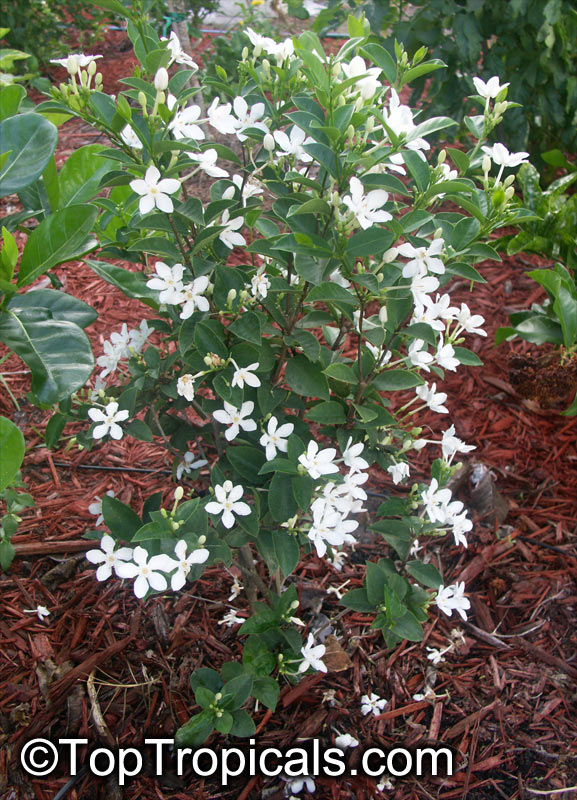

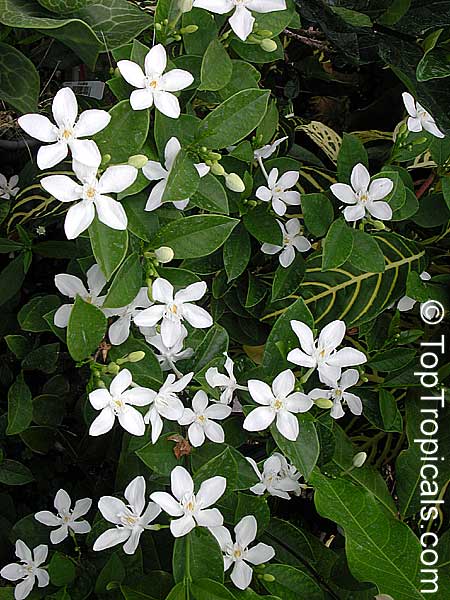
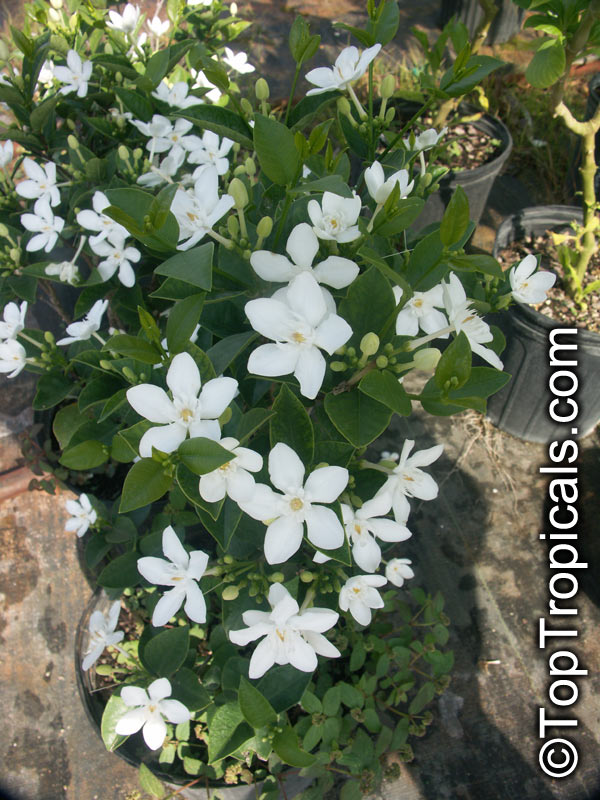
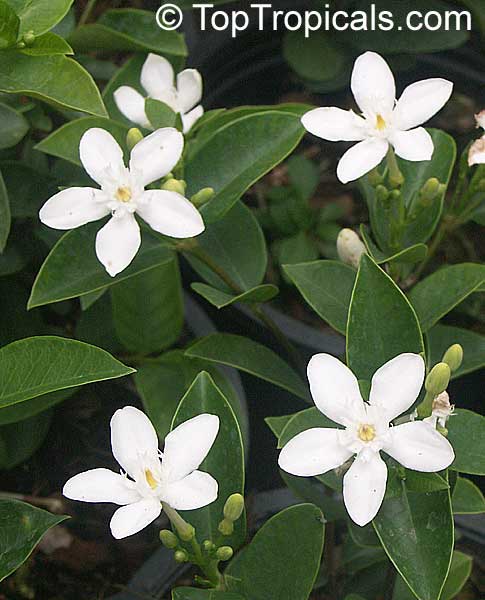
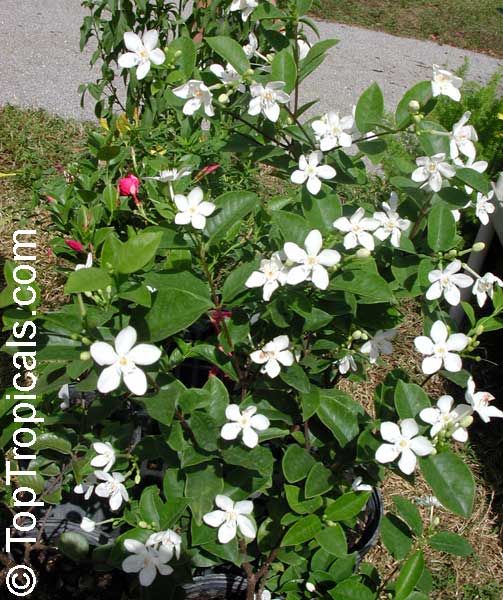
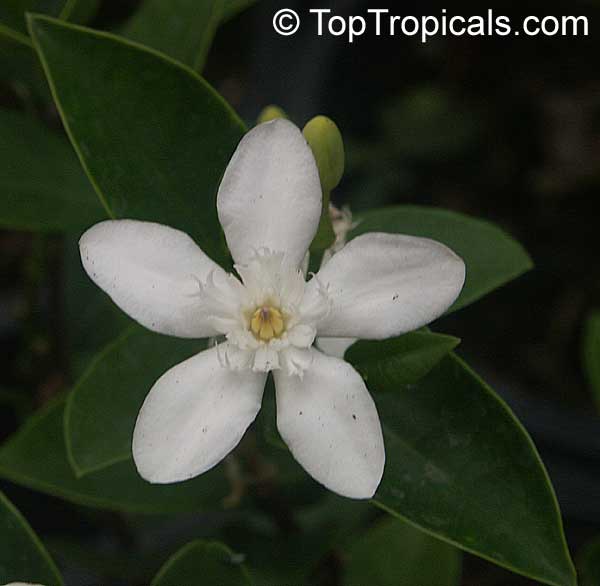
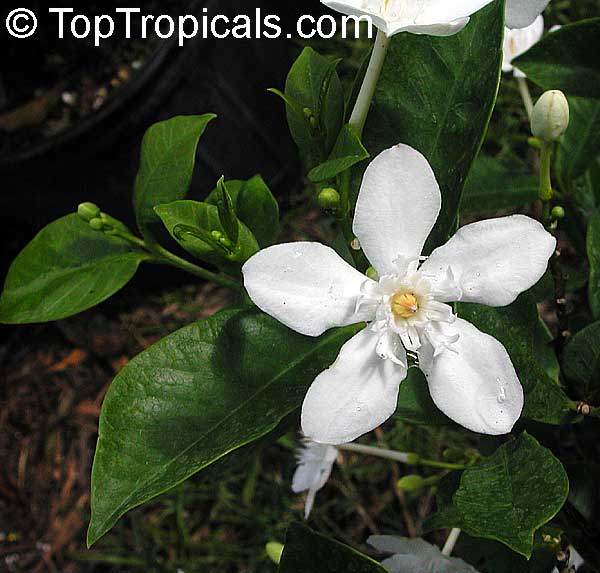
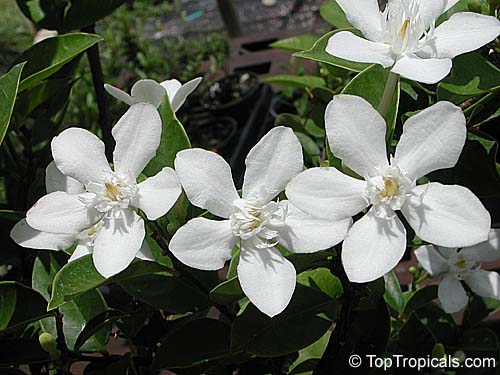
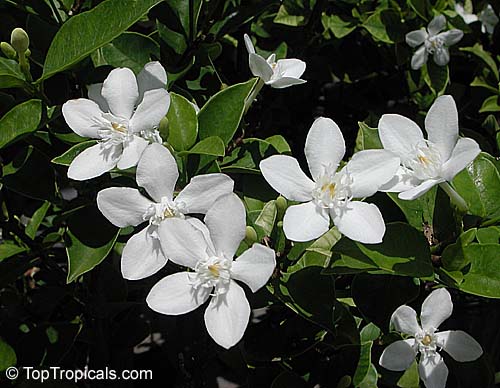
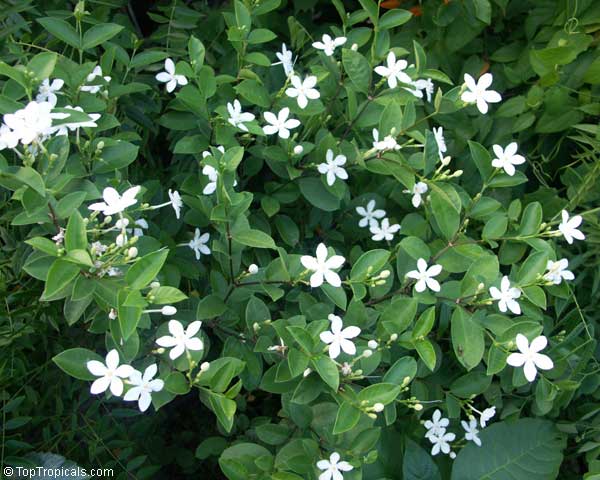
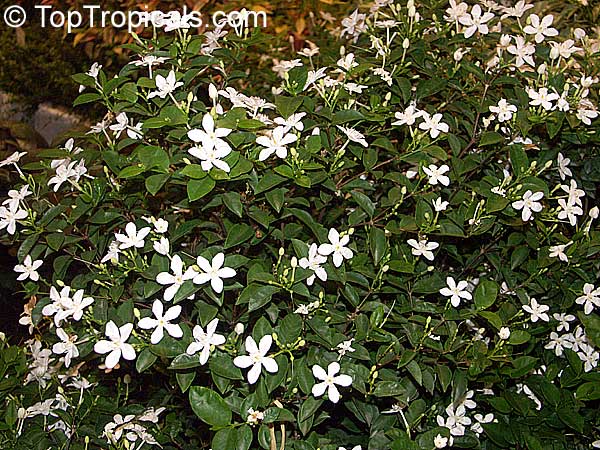
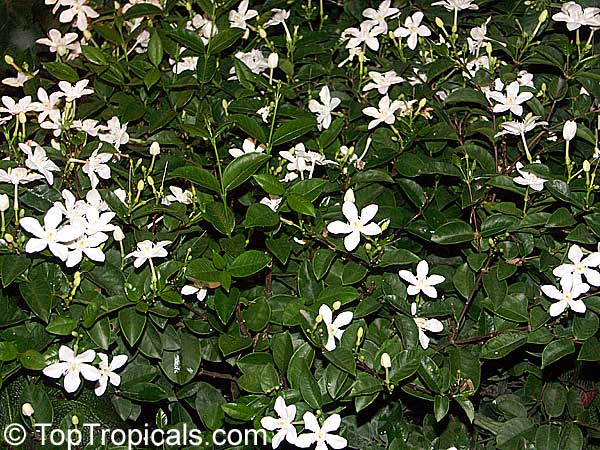
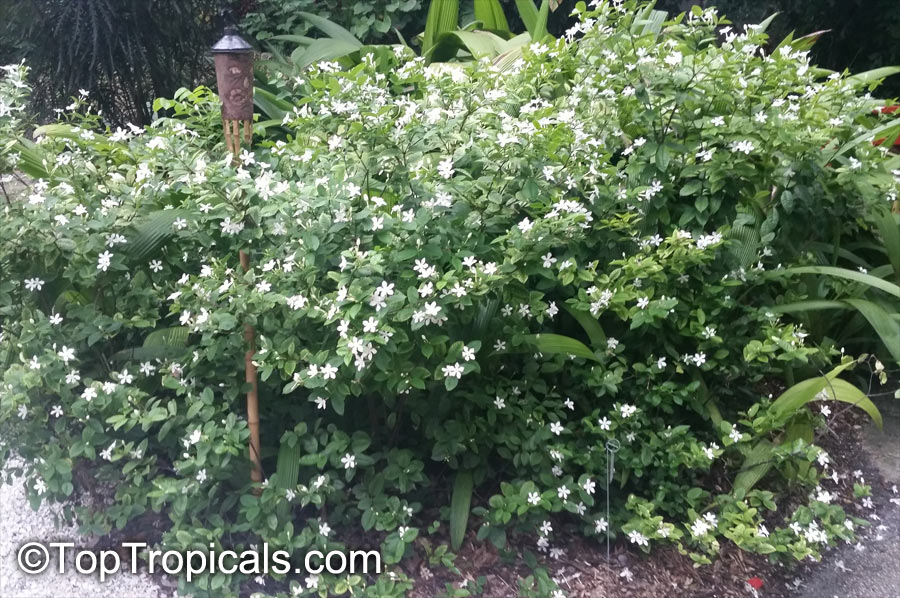
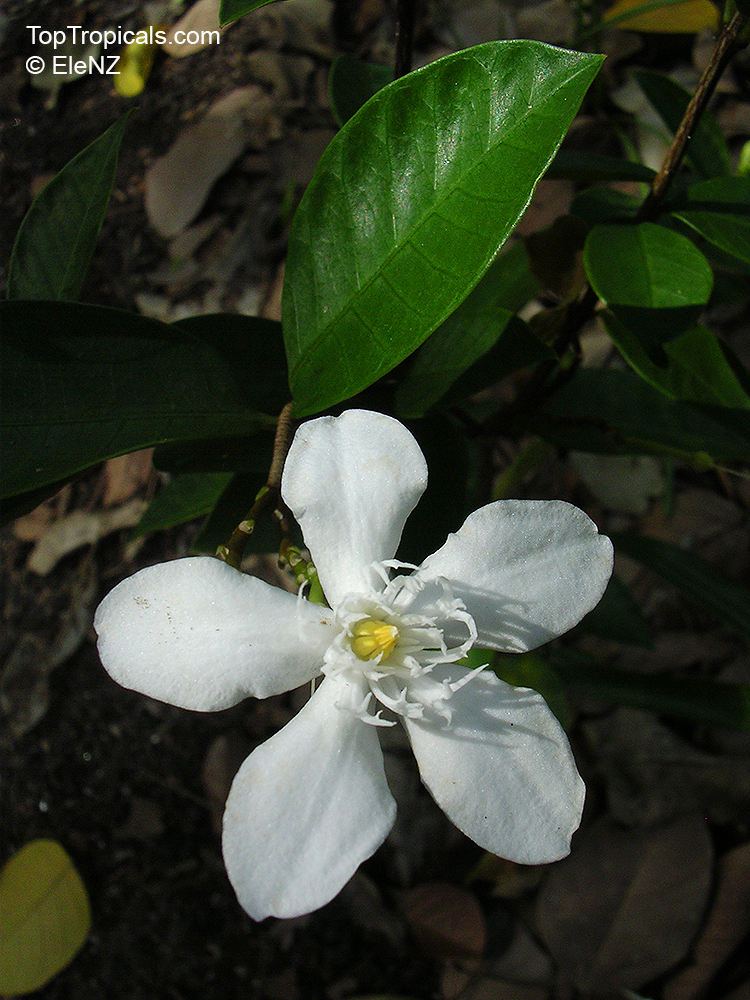
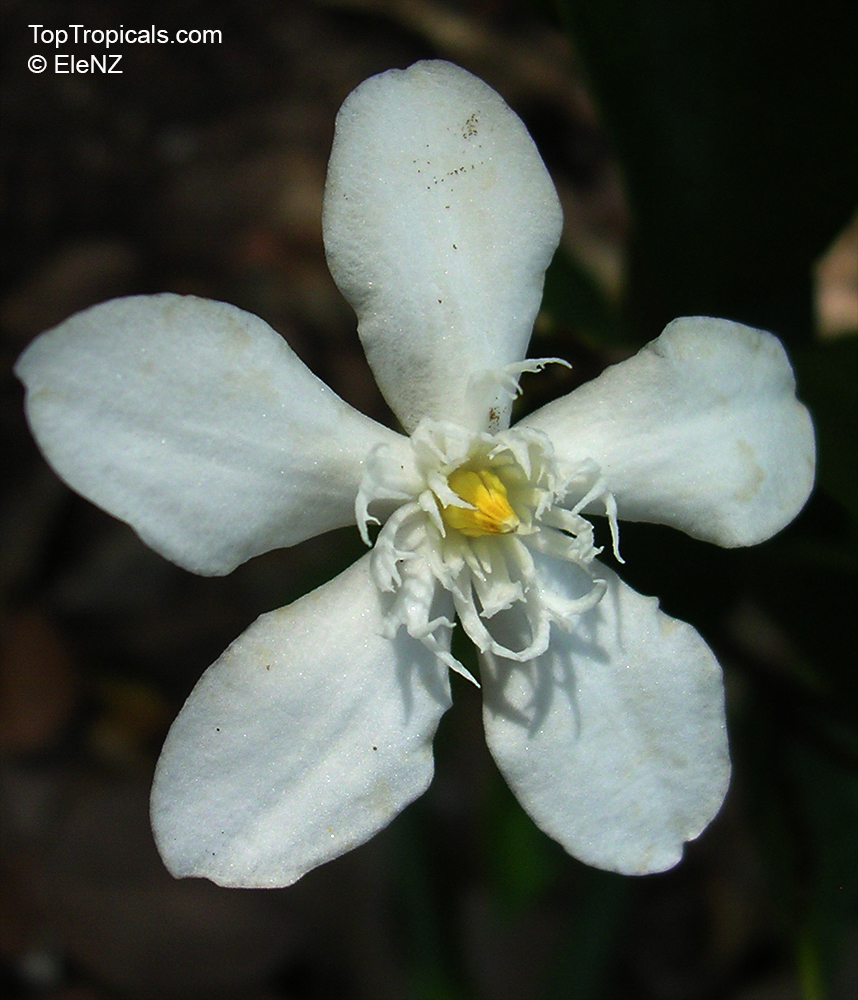
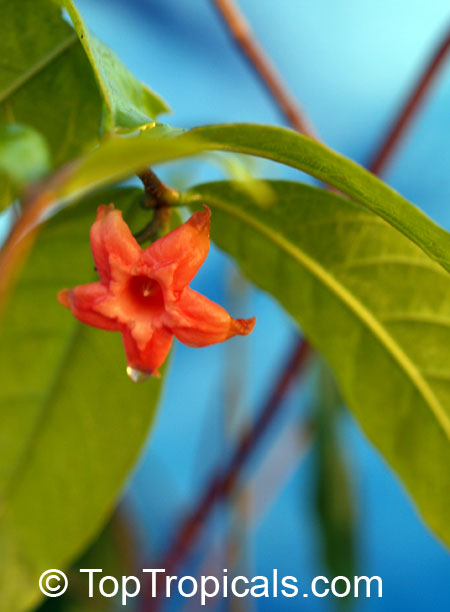
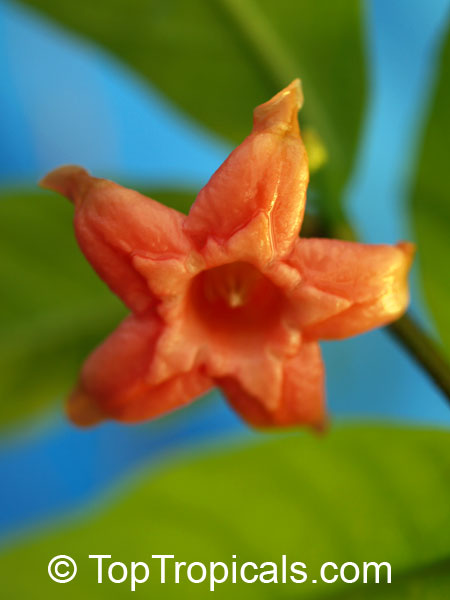
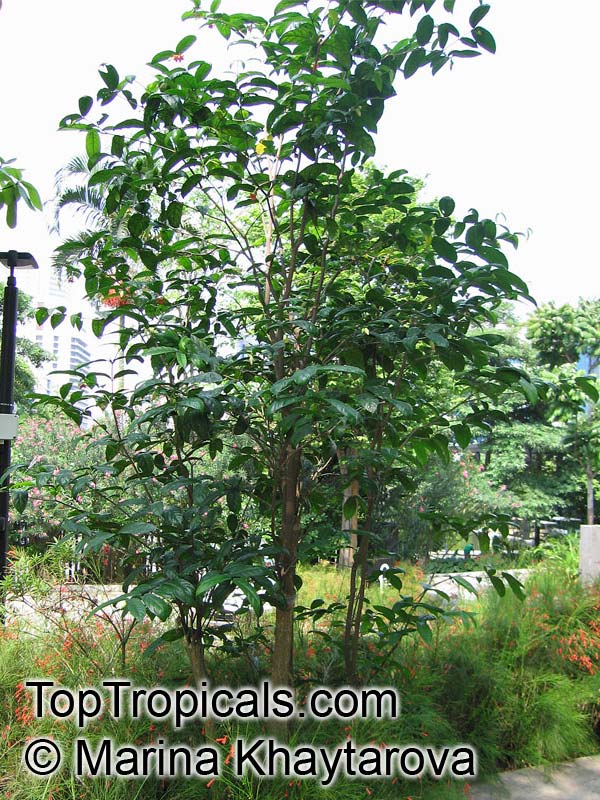
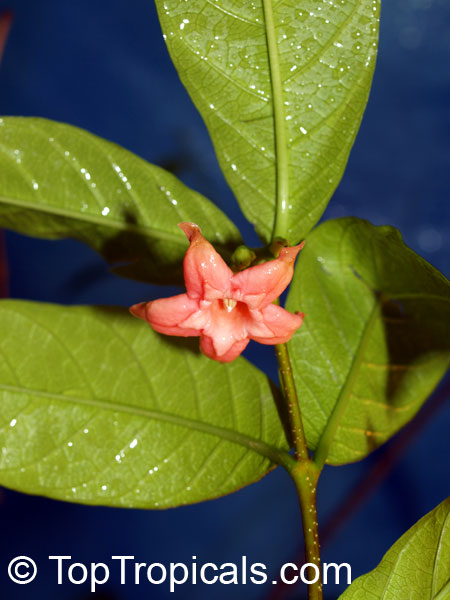
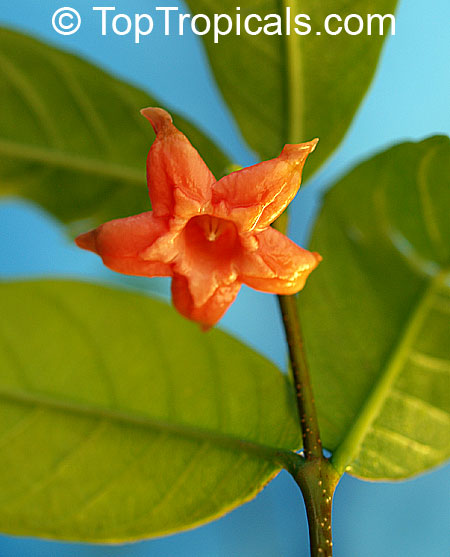
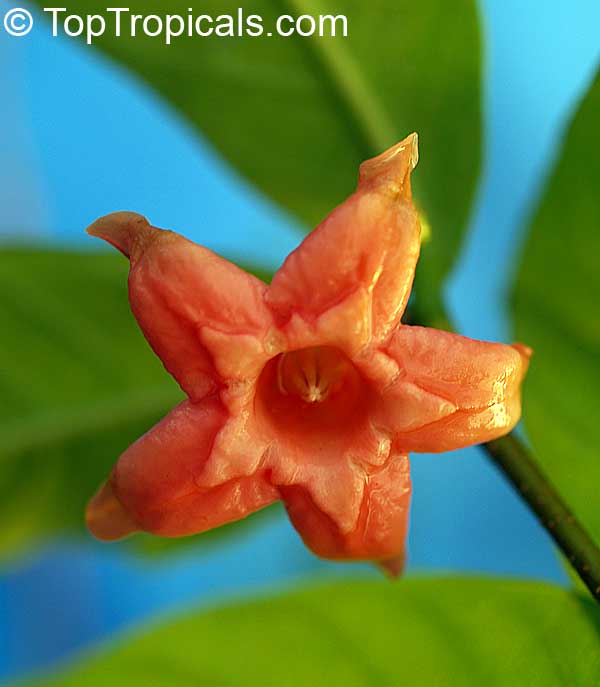
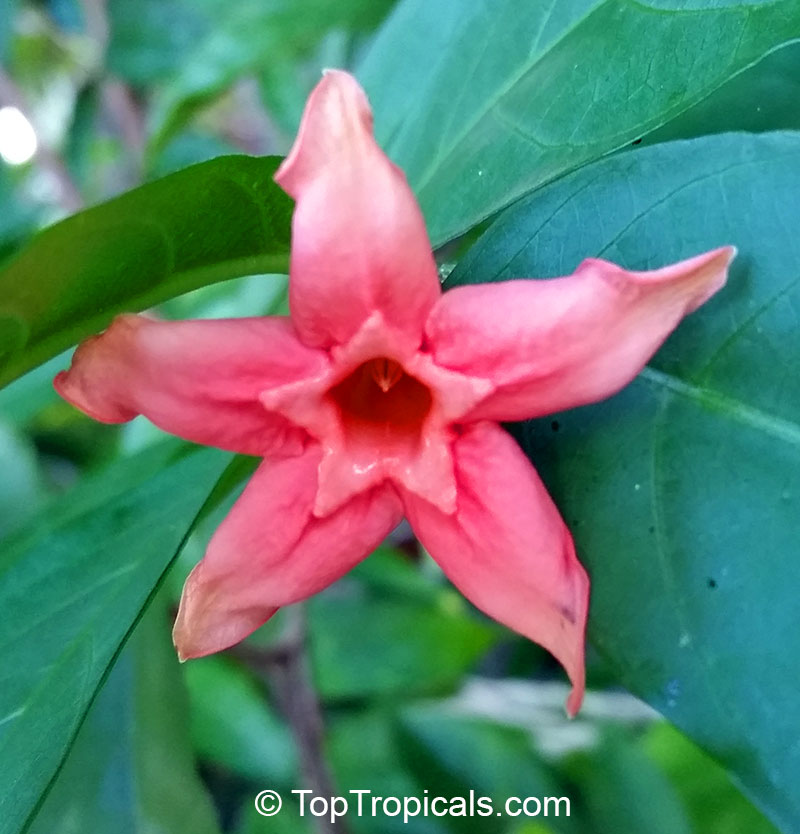
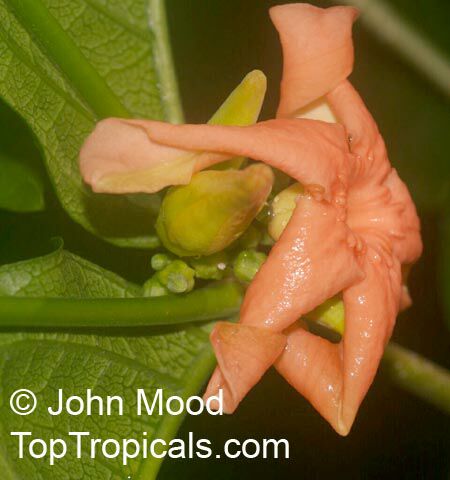
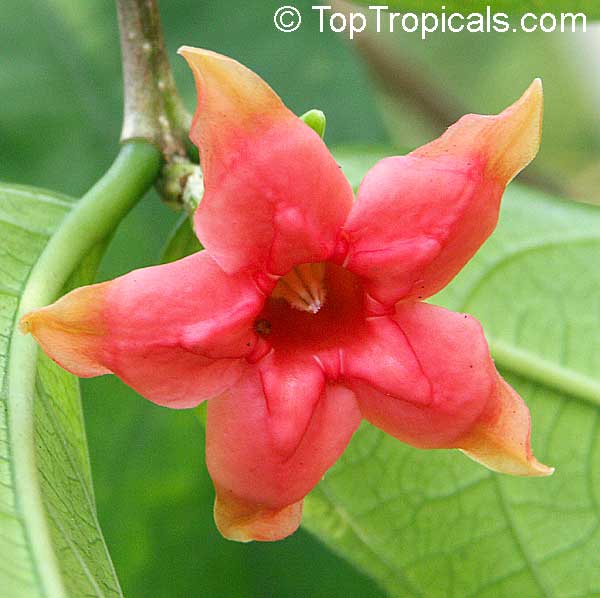
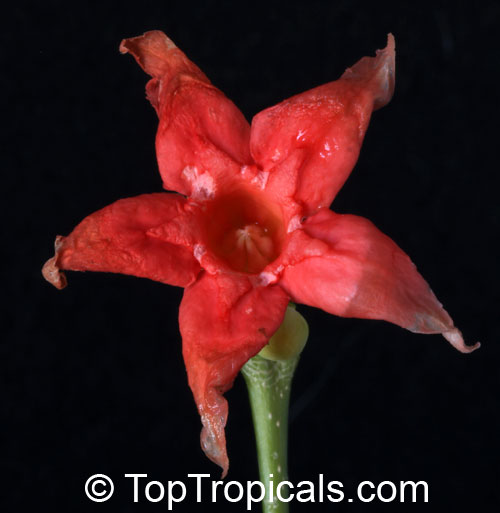
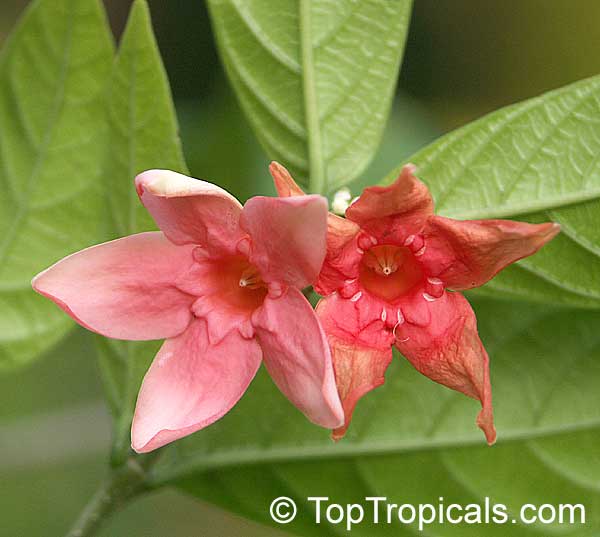
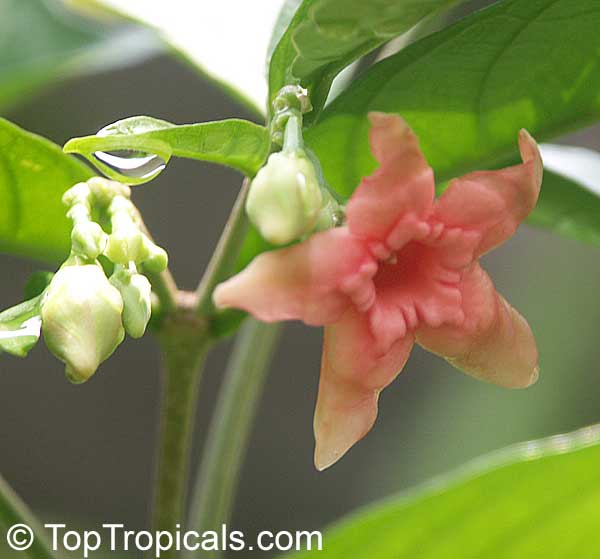
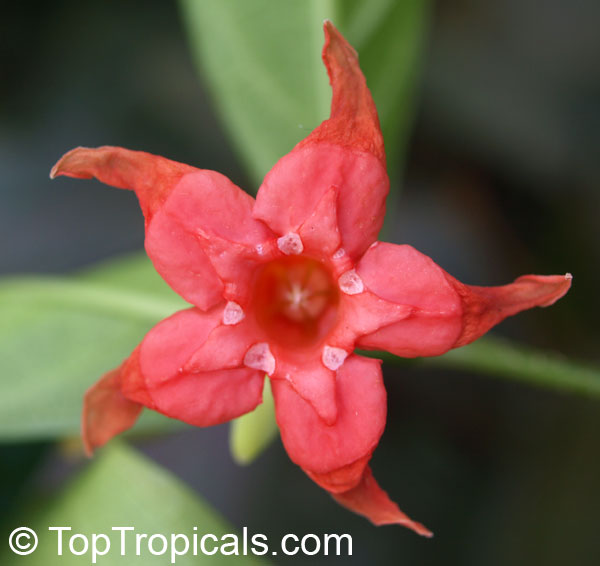
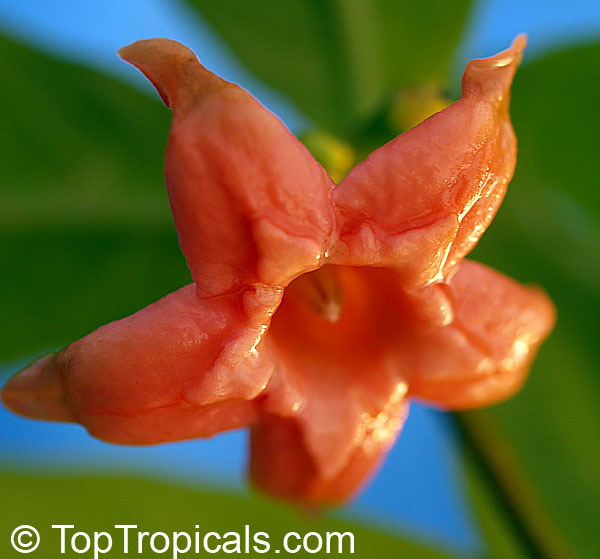
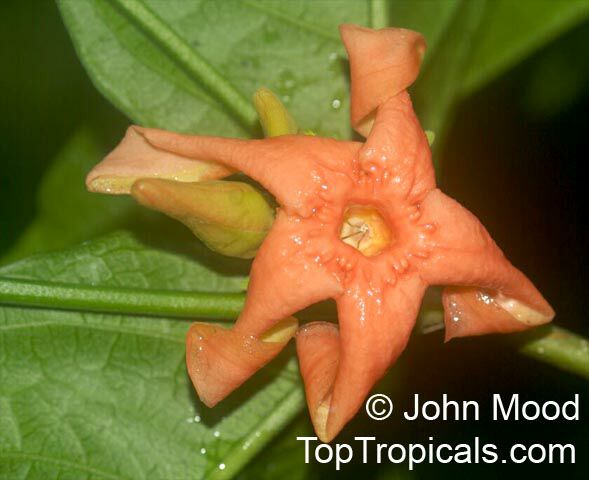
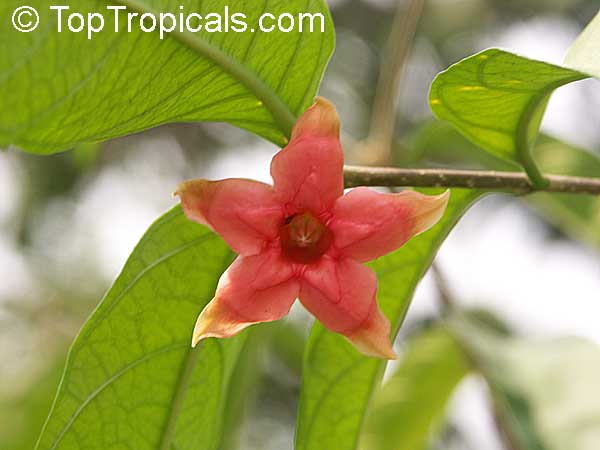
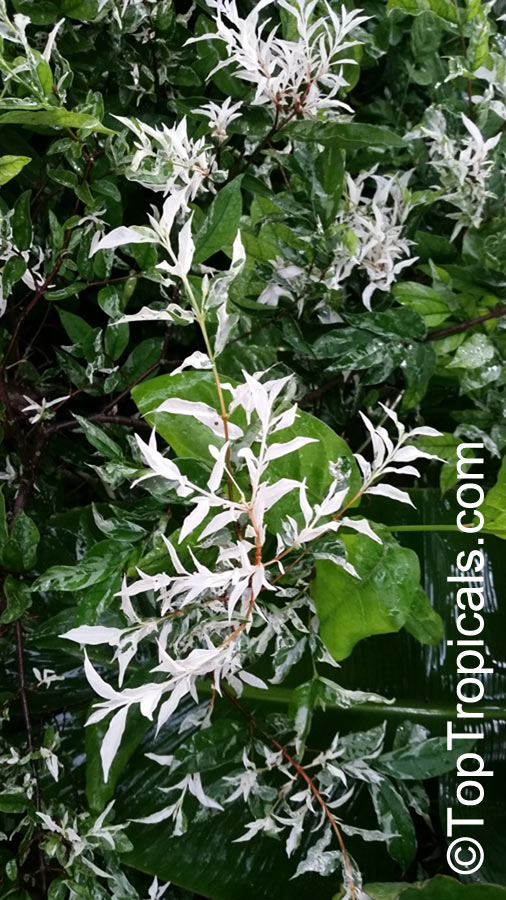
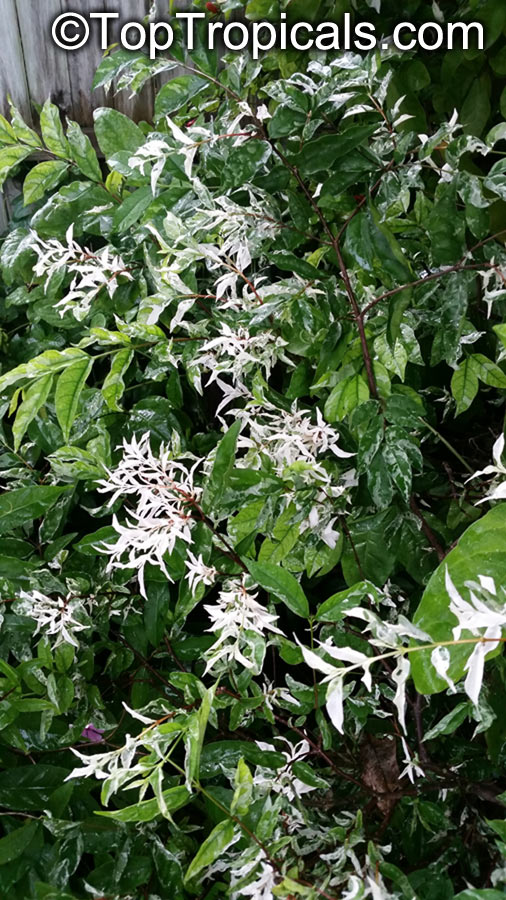
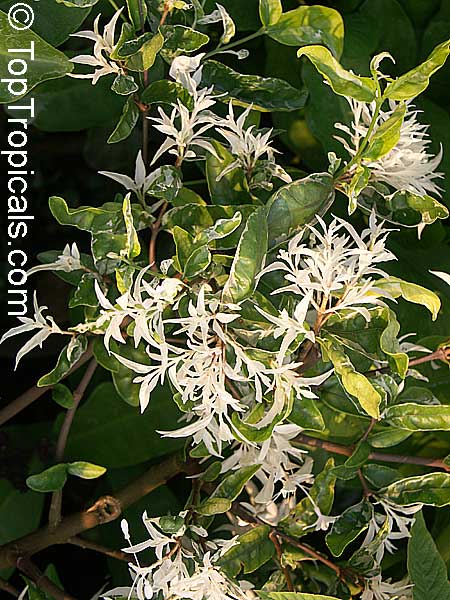
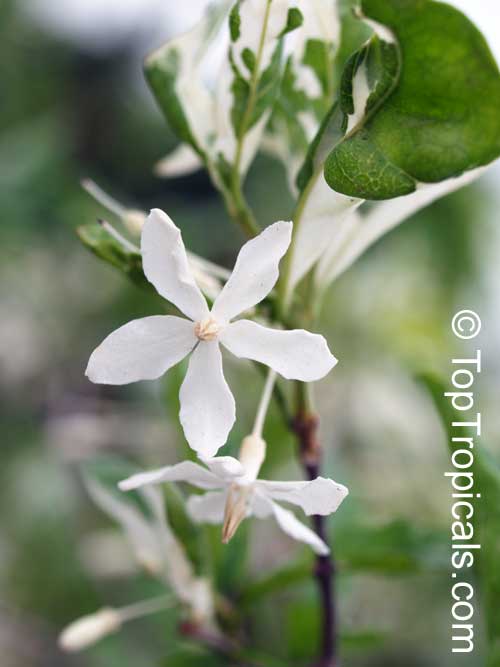
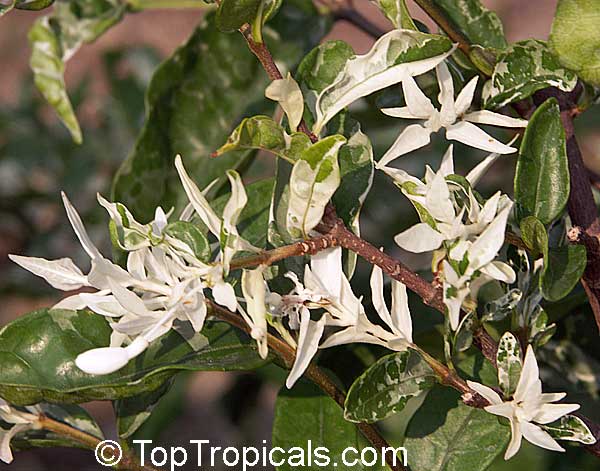
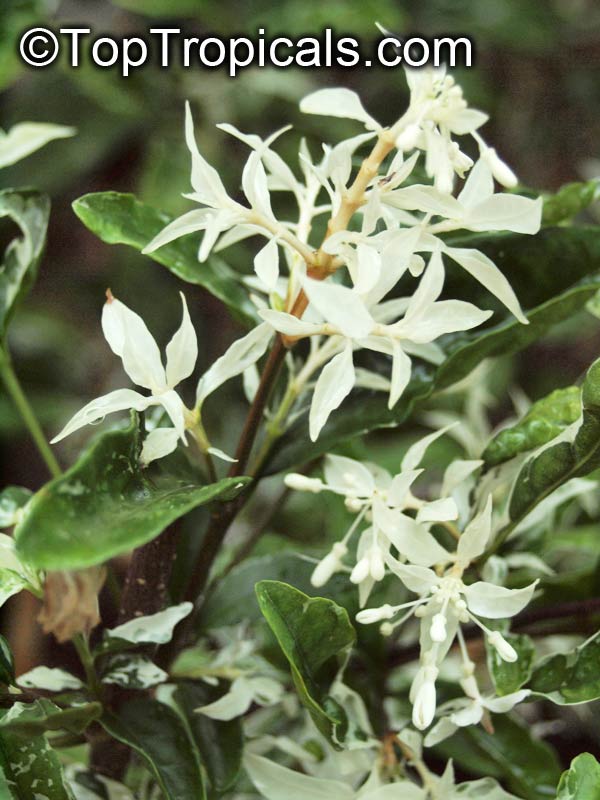
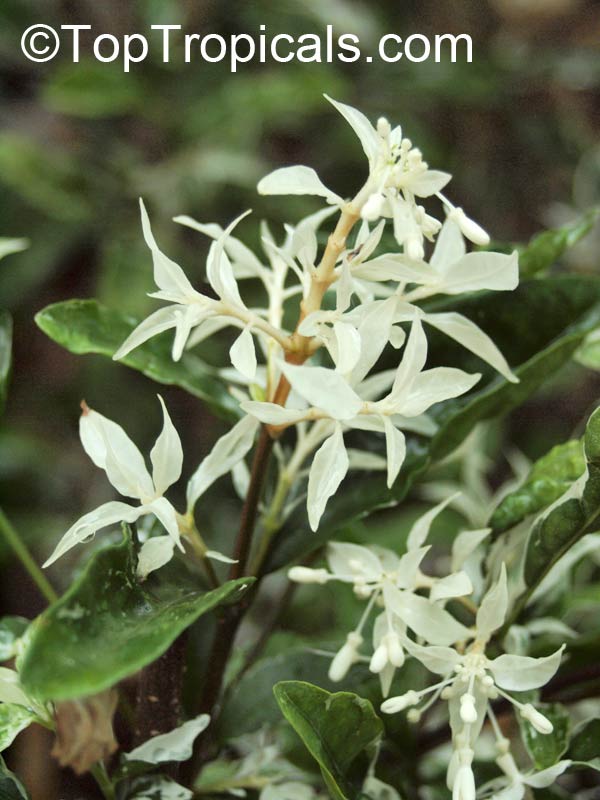
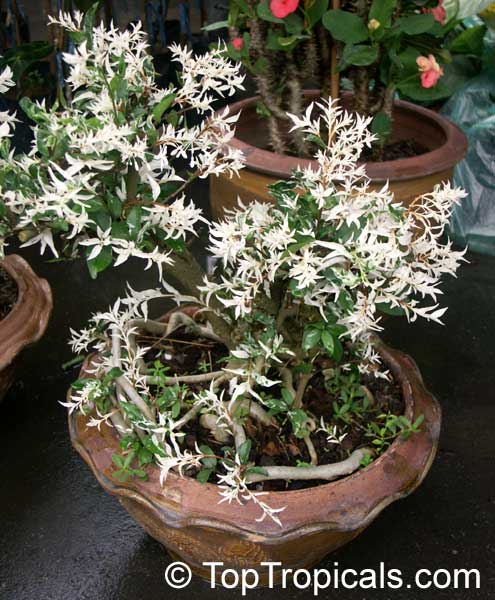
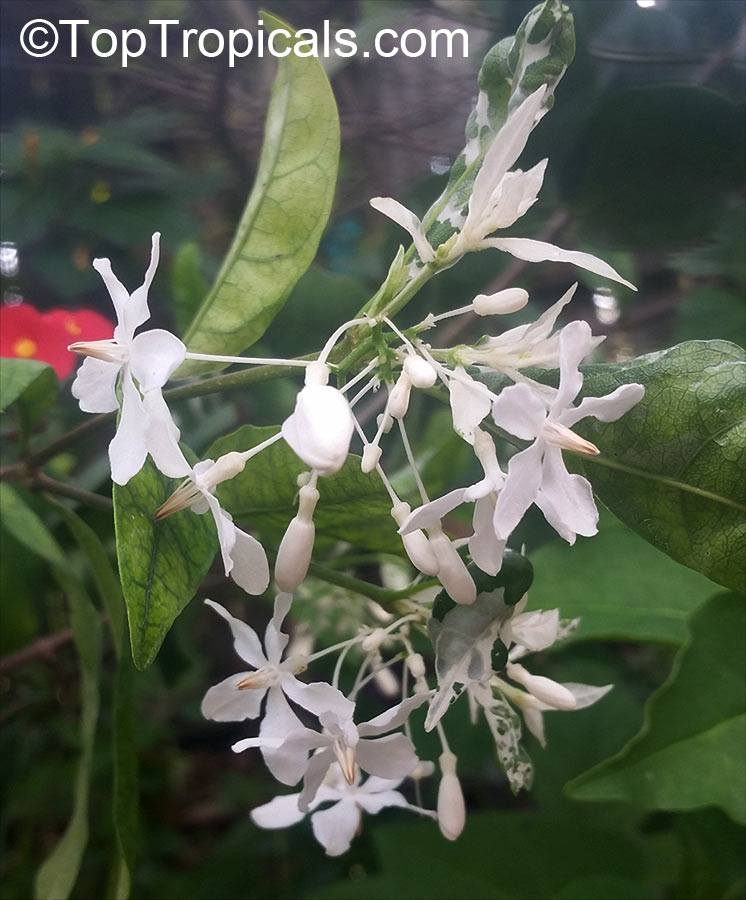
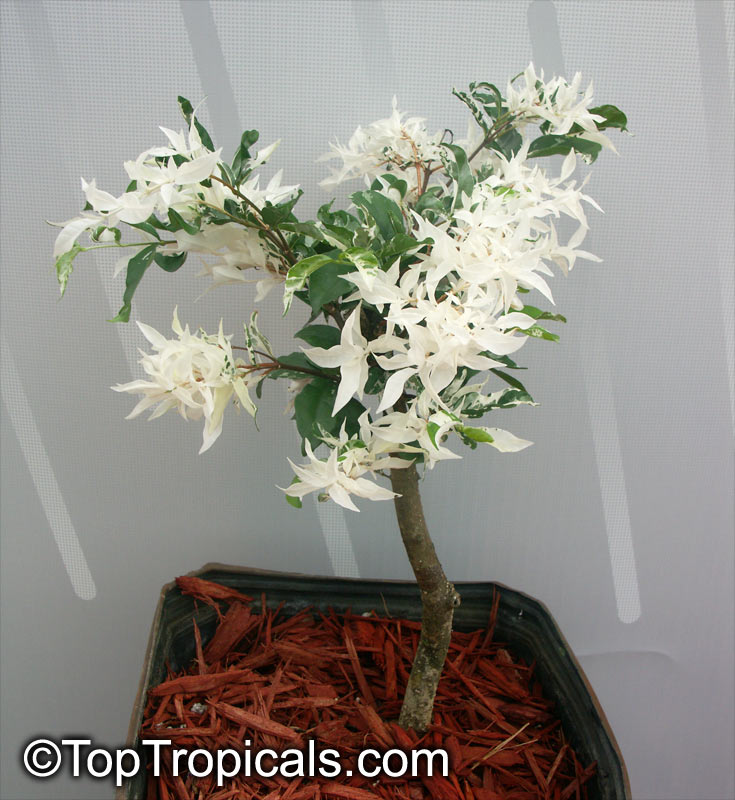
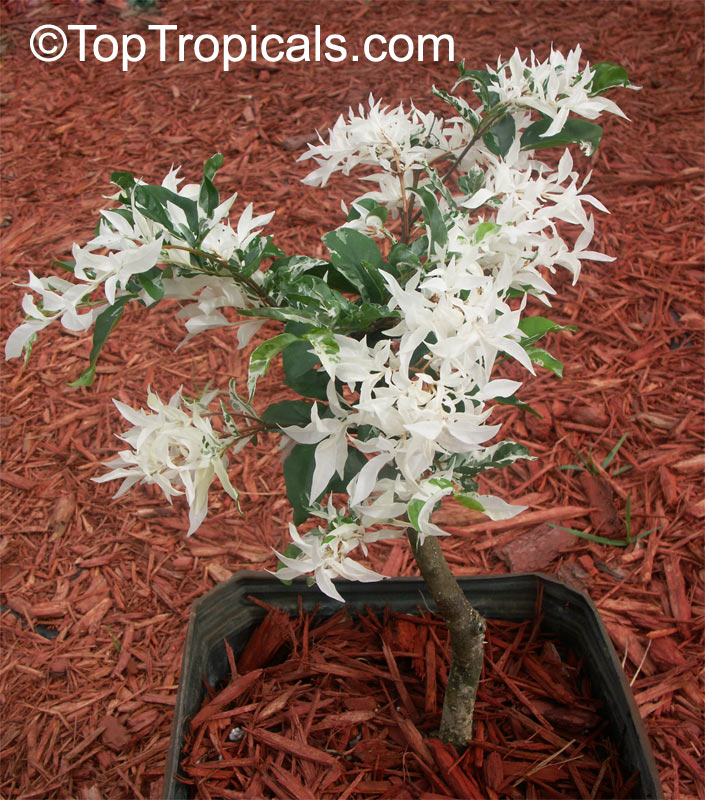
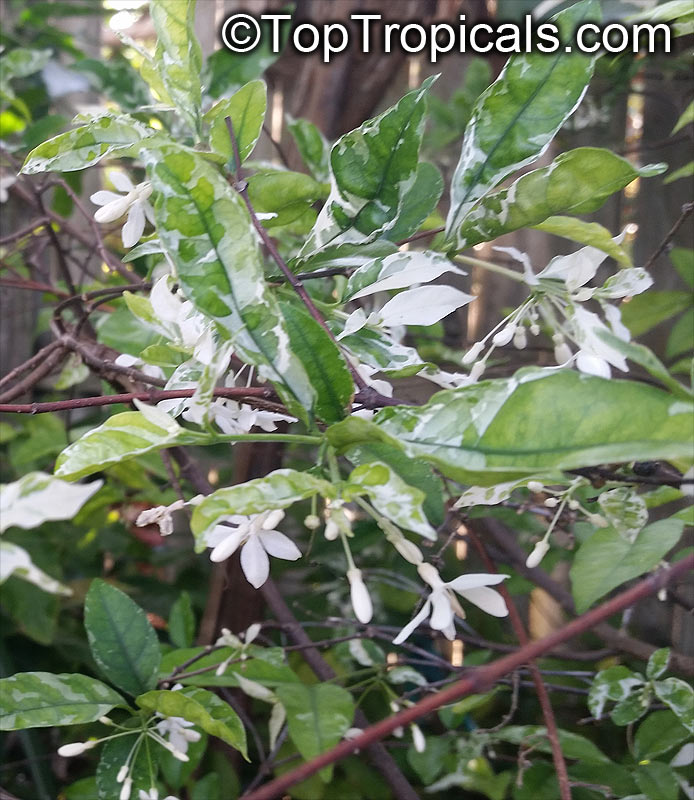
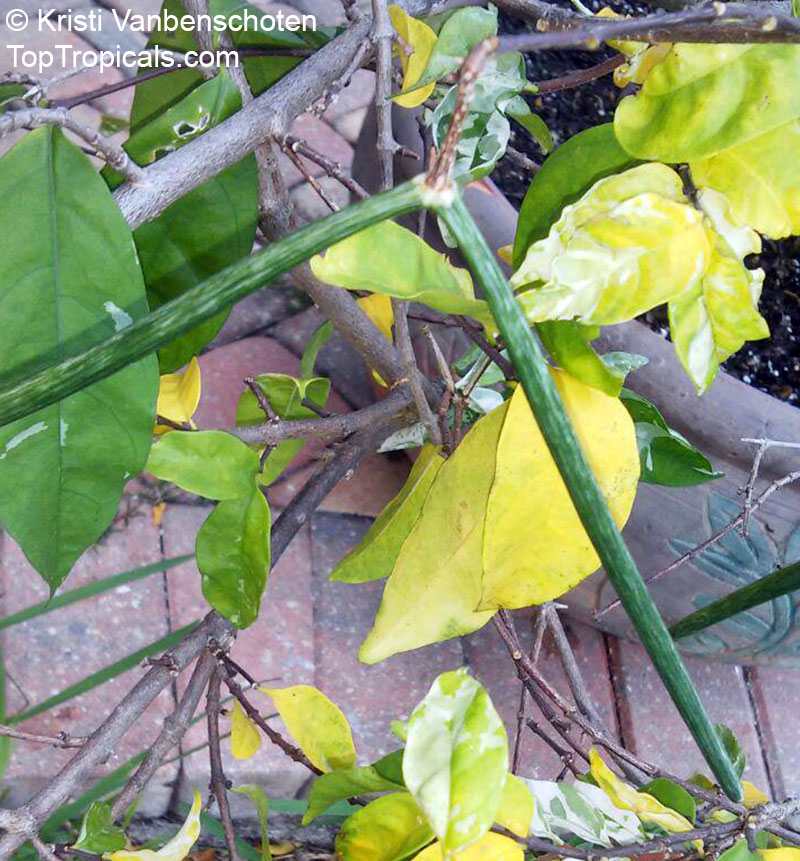
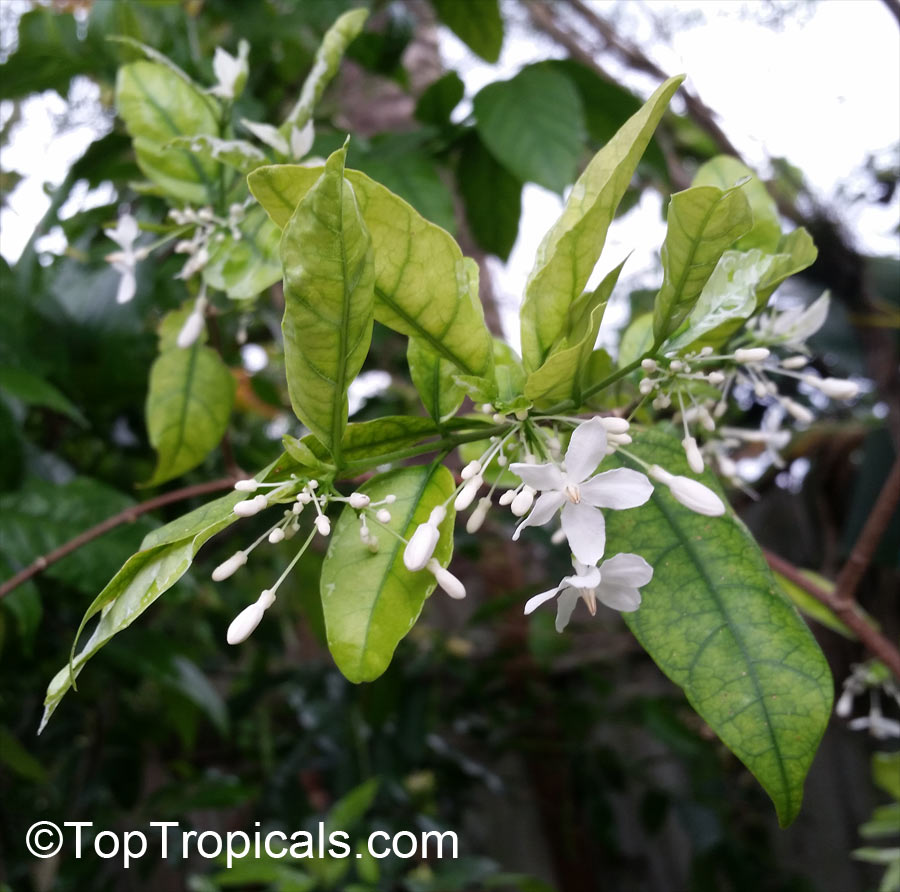


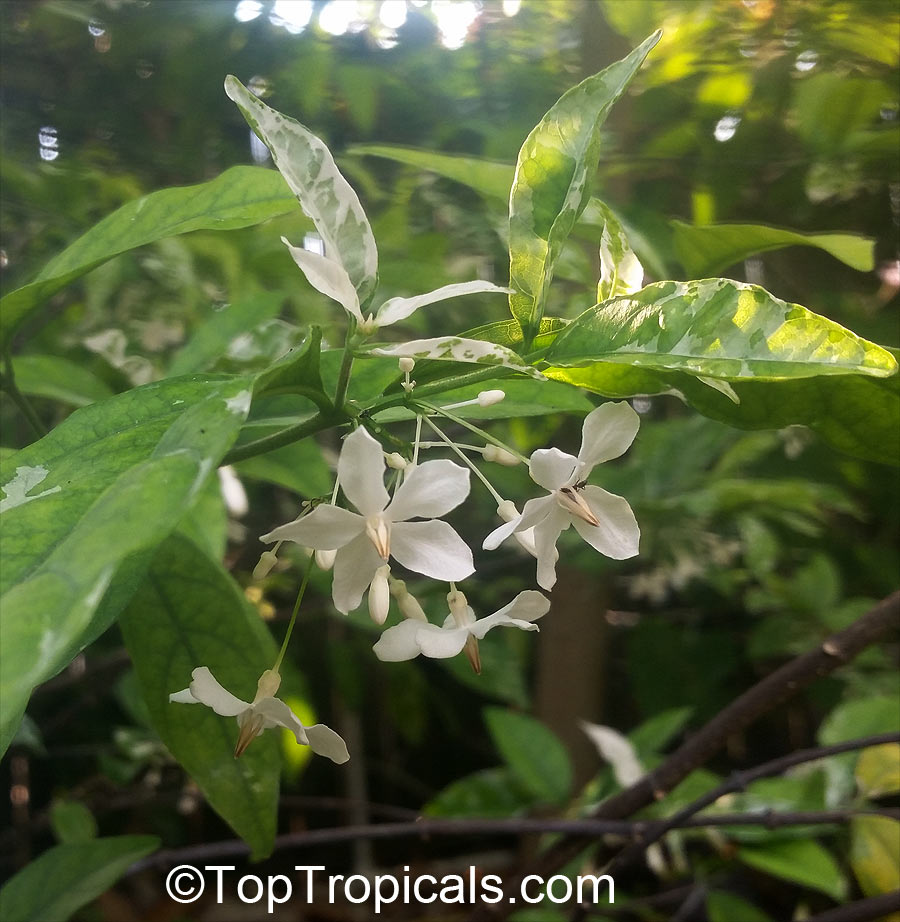
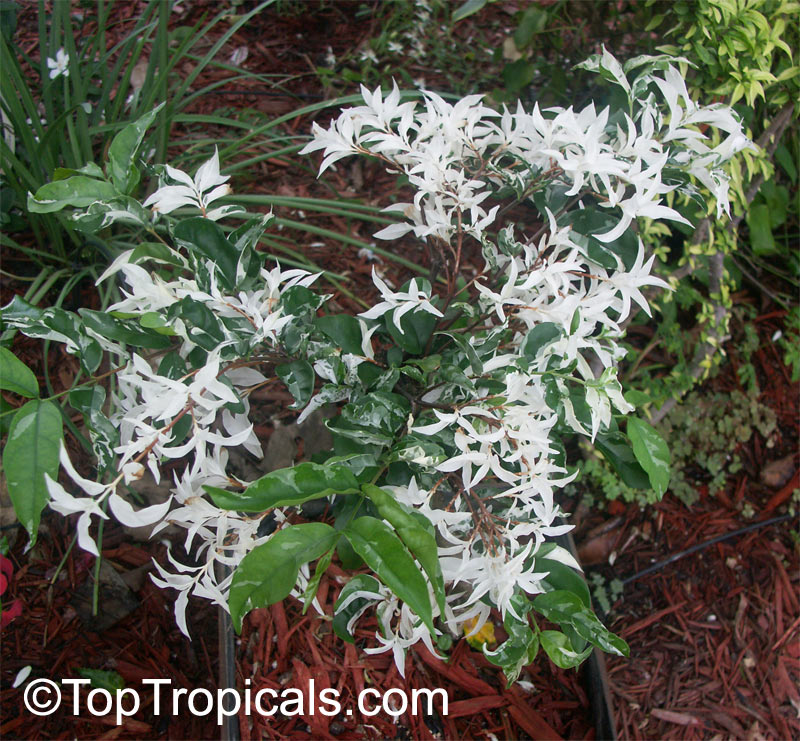
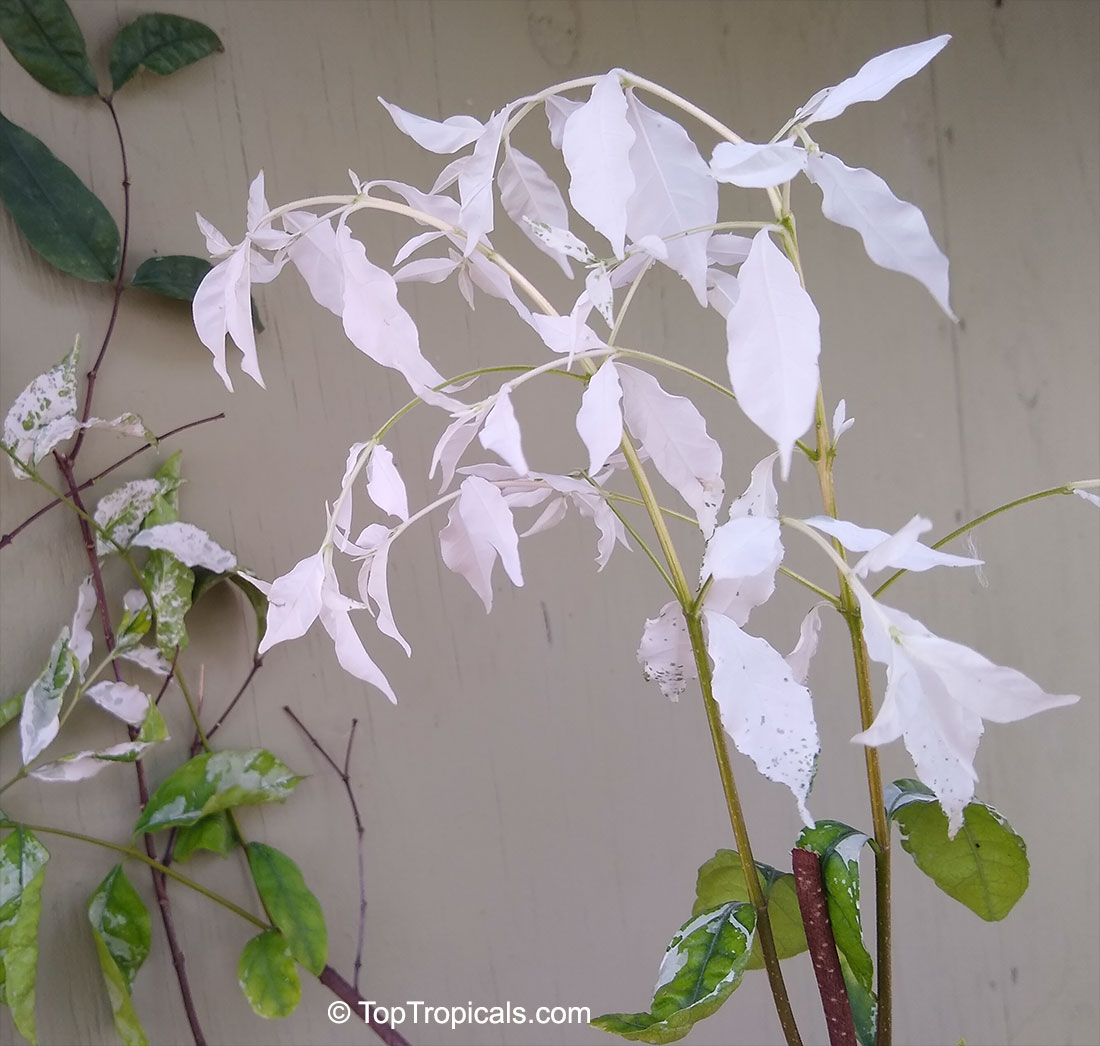
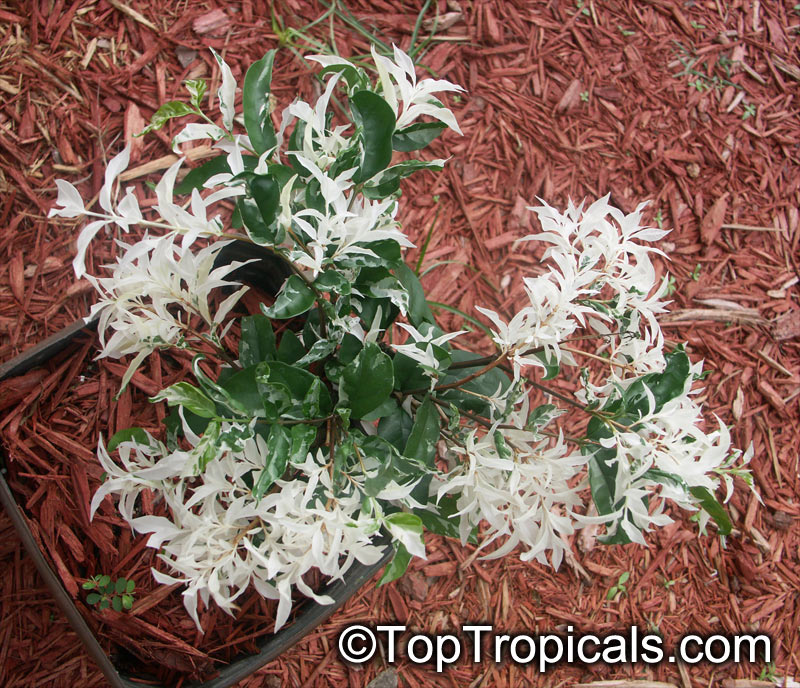
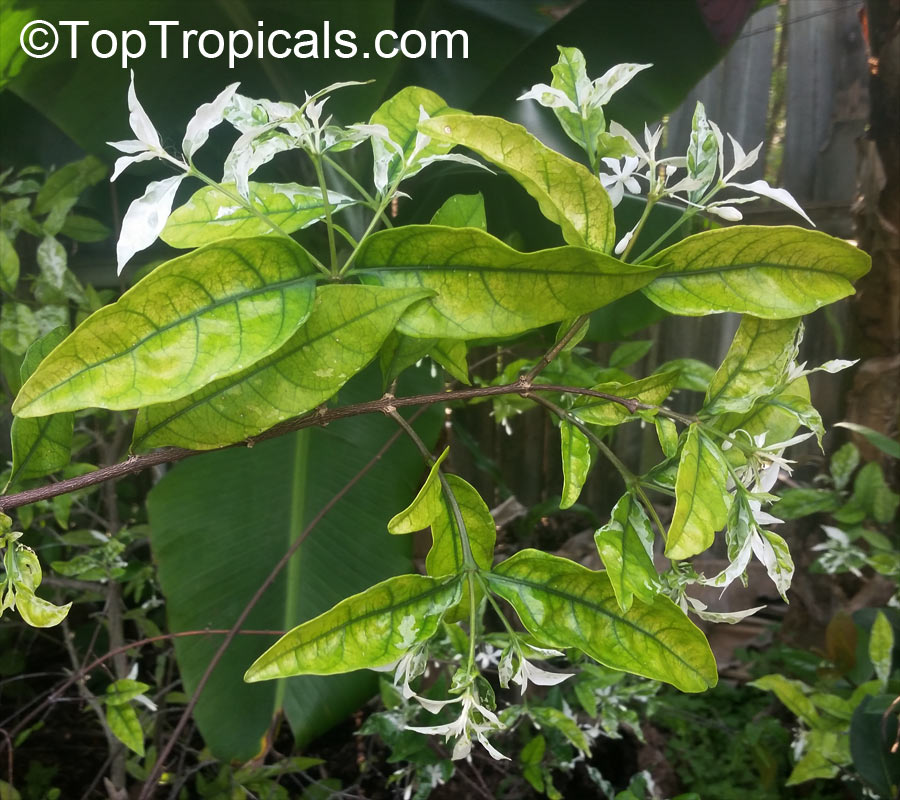
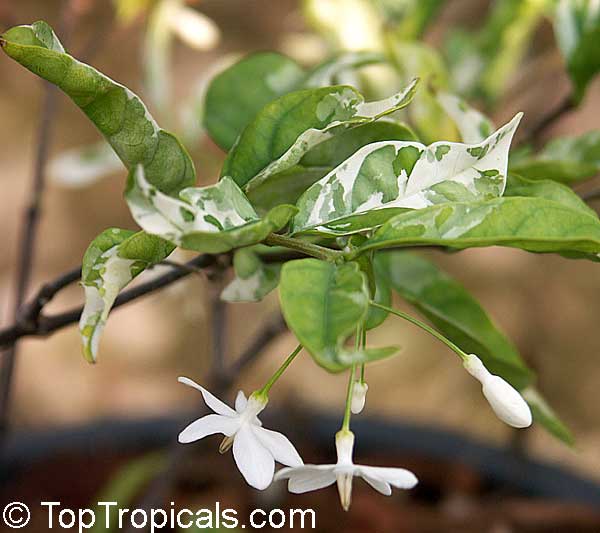
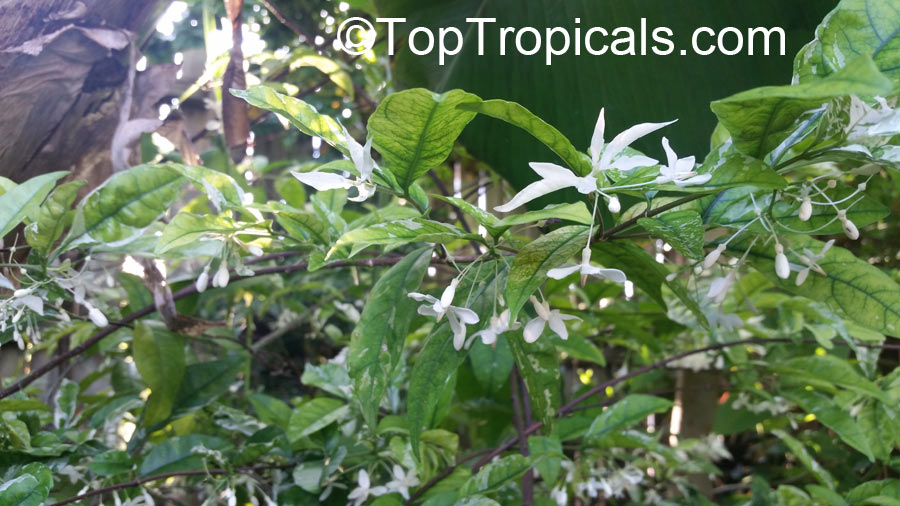
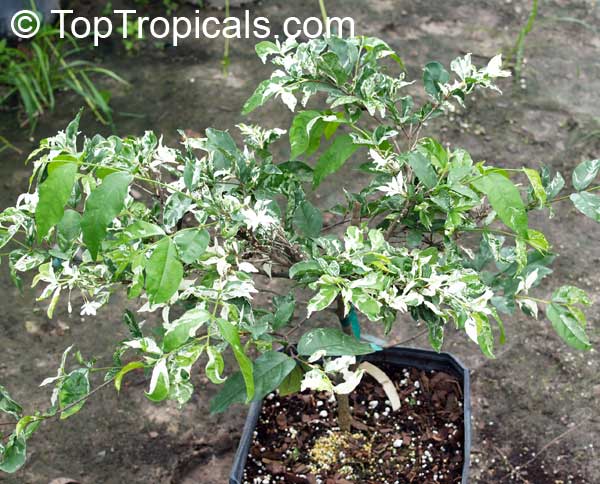

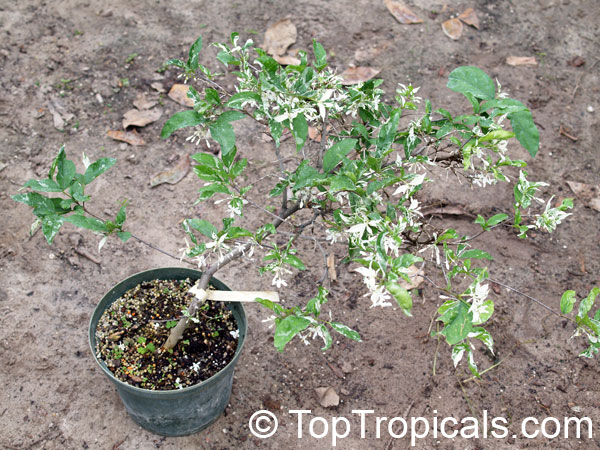
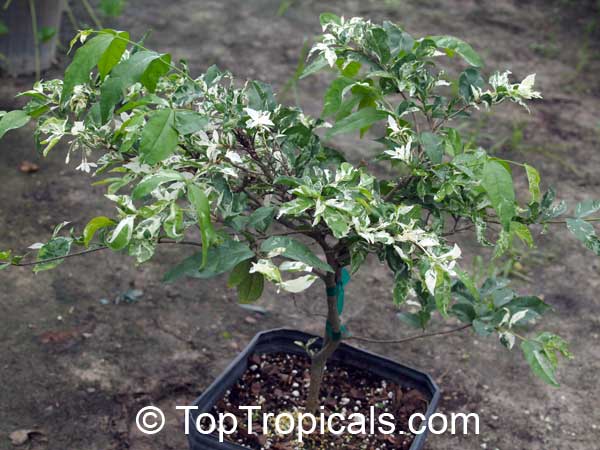
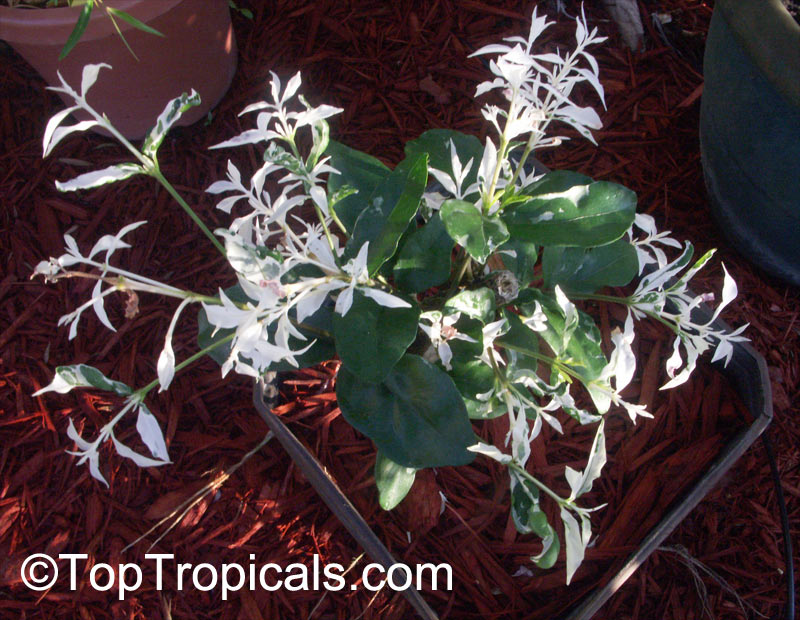
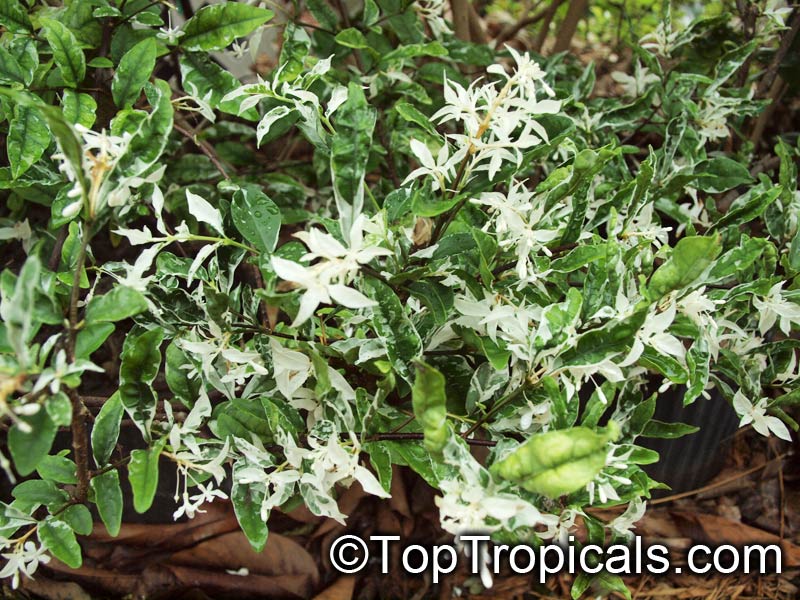
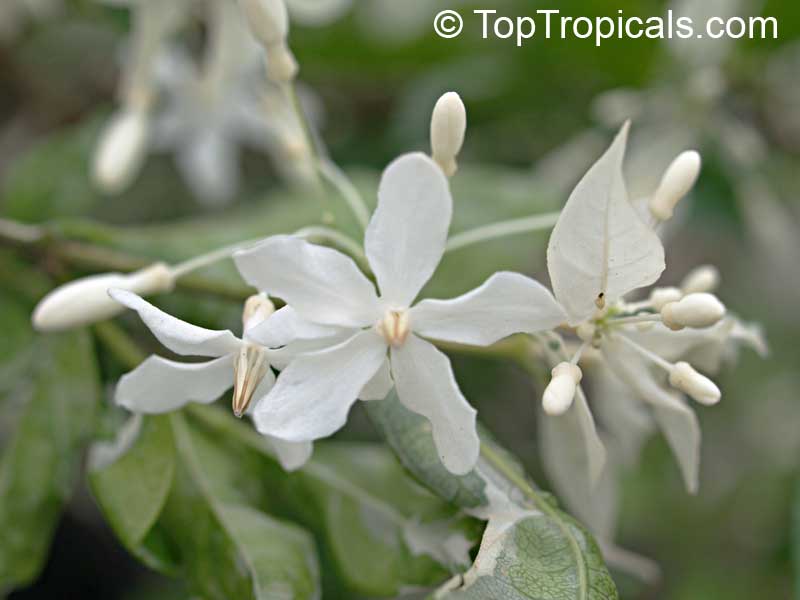
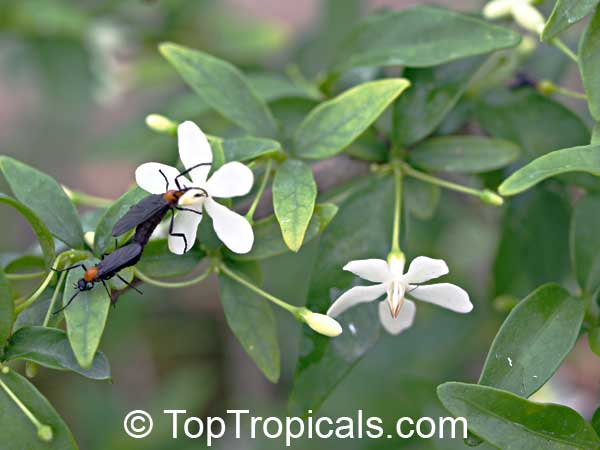
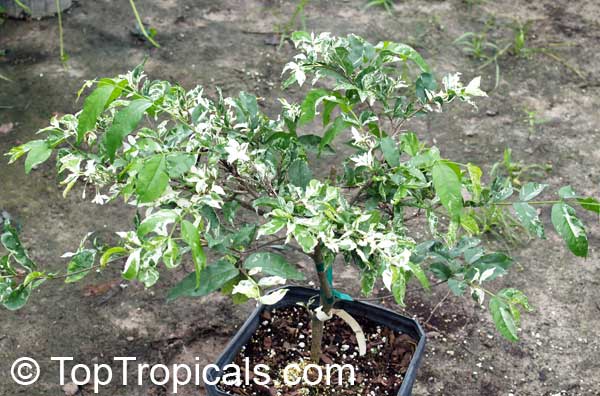
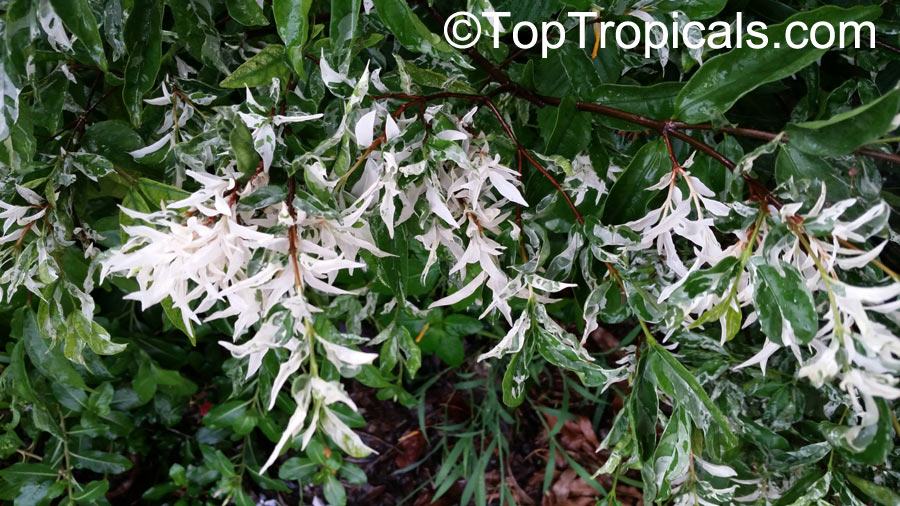
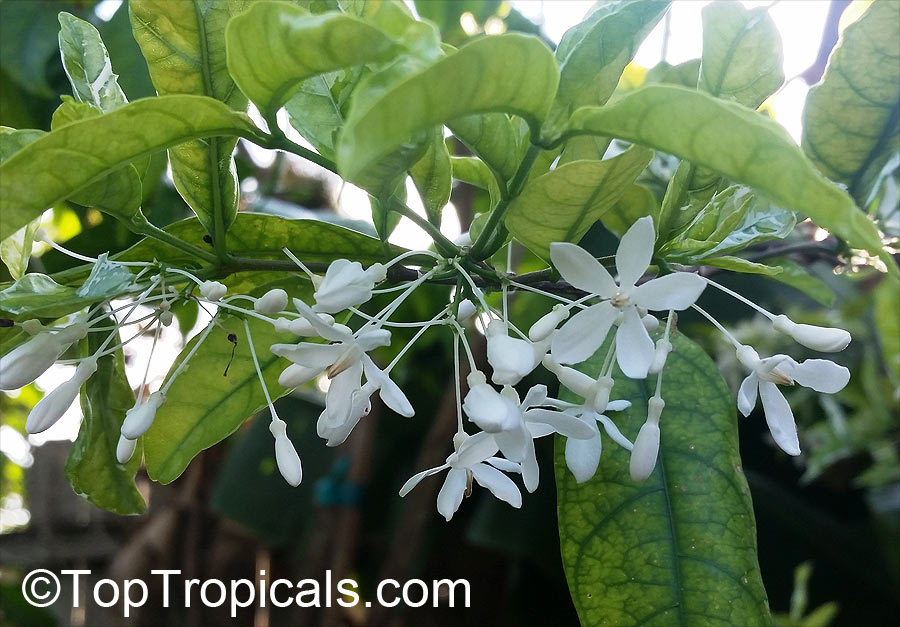
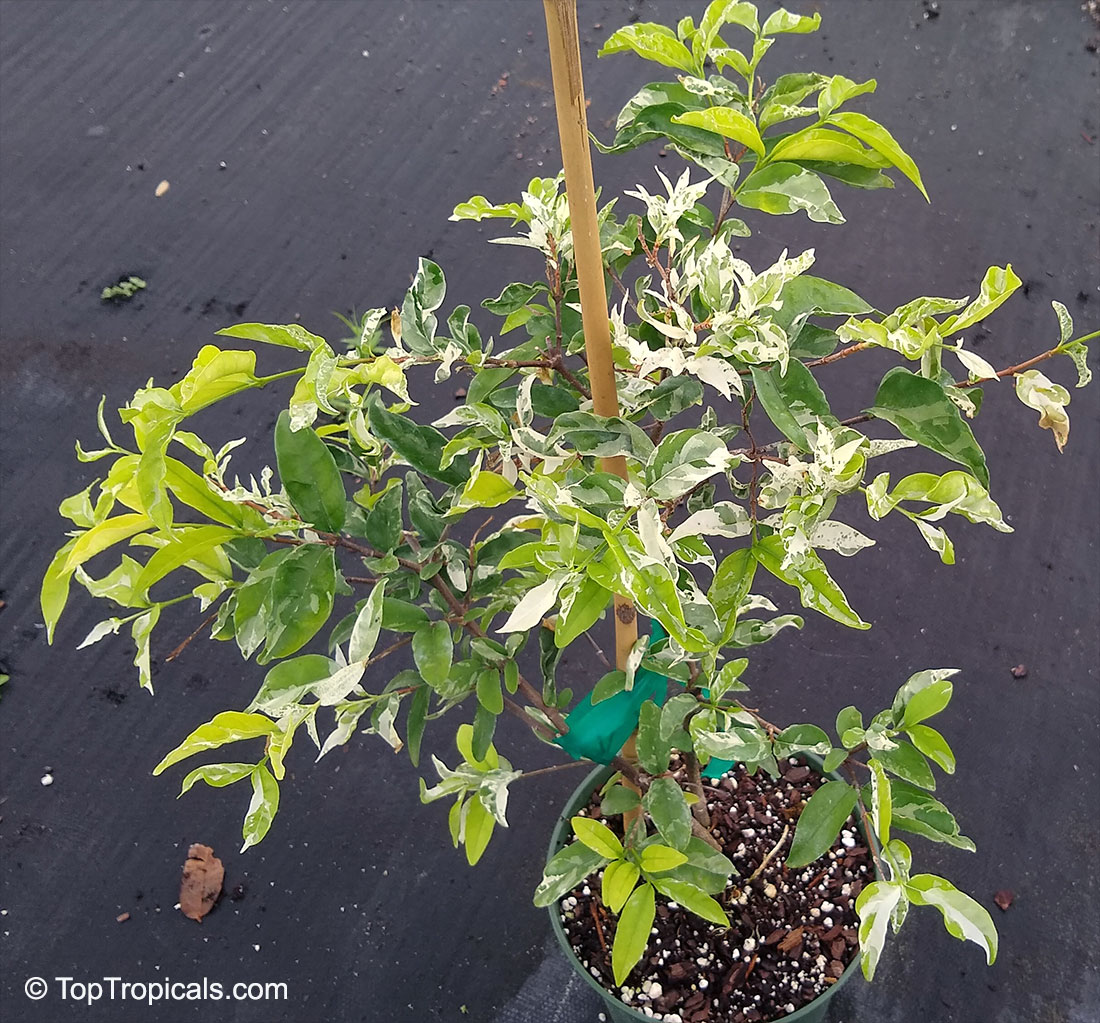

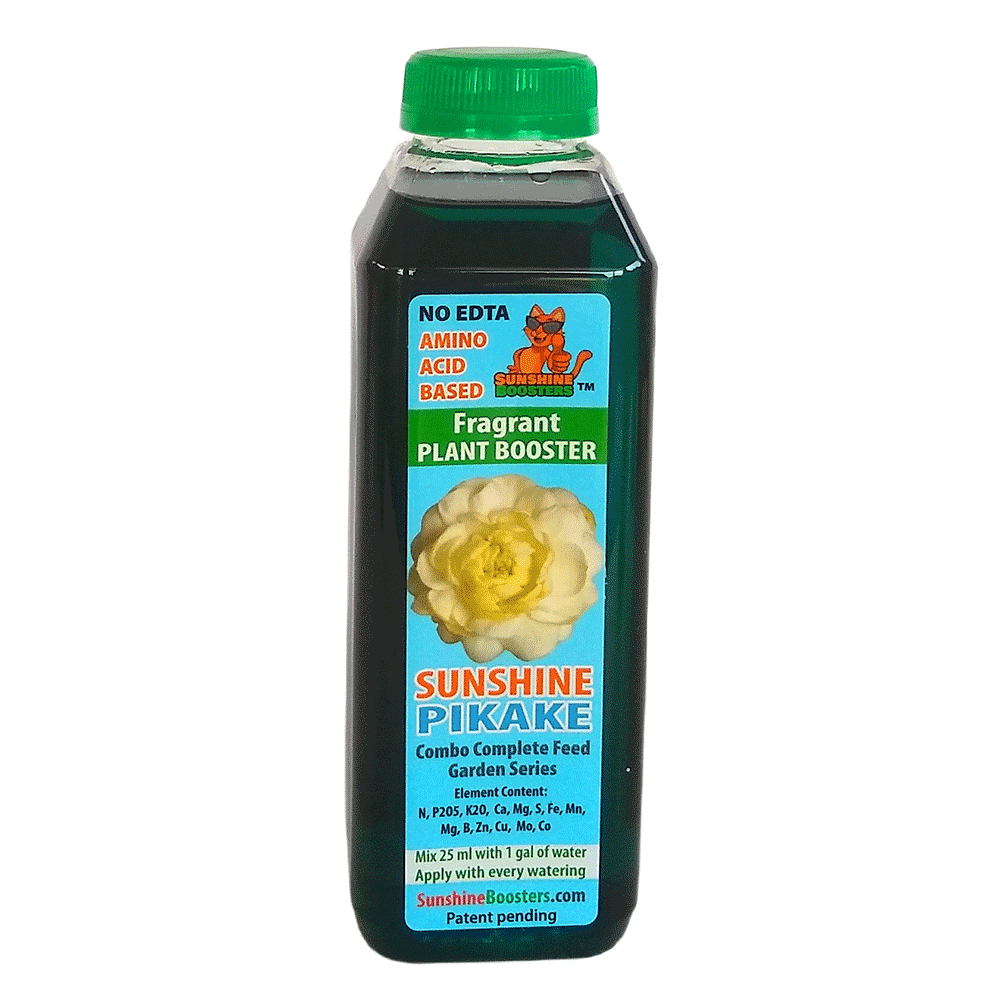 SUNSHINE Pikake (NPK 2-2-4) - eco-friendly concentrated nutrition booster for fragrant flowers. Improves quantity and quality of flowers. Encourages profuse blooming. Increases flower fragrance intensity. Can be used with every watering. For best results, use in combination with
SUNSHINE Pikake (NPK 2-2-4) - eco-friendly concentrated nutrition booster for fragrant flowers. Improves quantity and quality of flowers. Encourages profuse blooming. Increases flower fragrance intensity. Can be used with every watering. For best results, use in combination with 